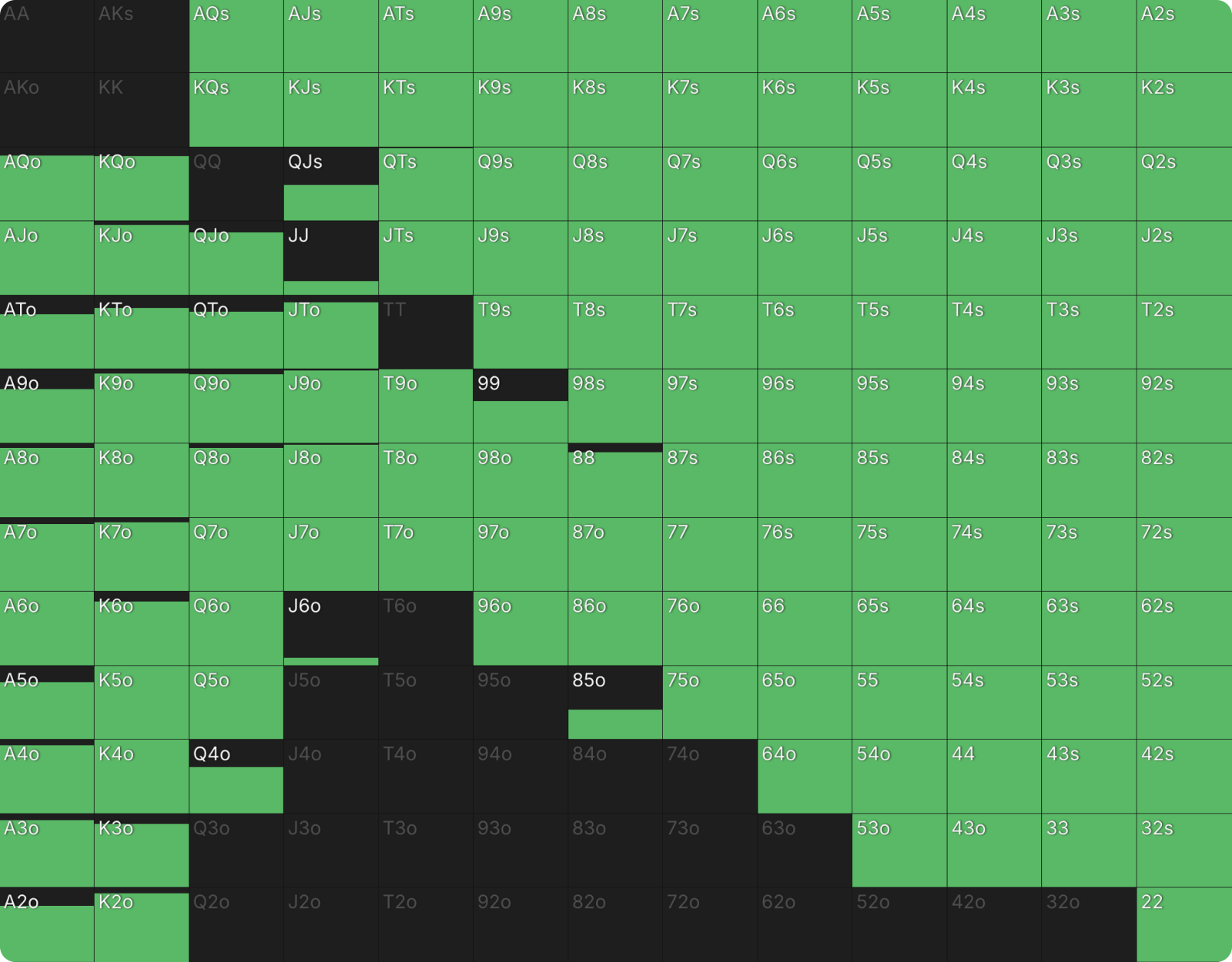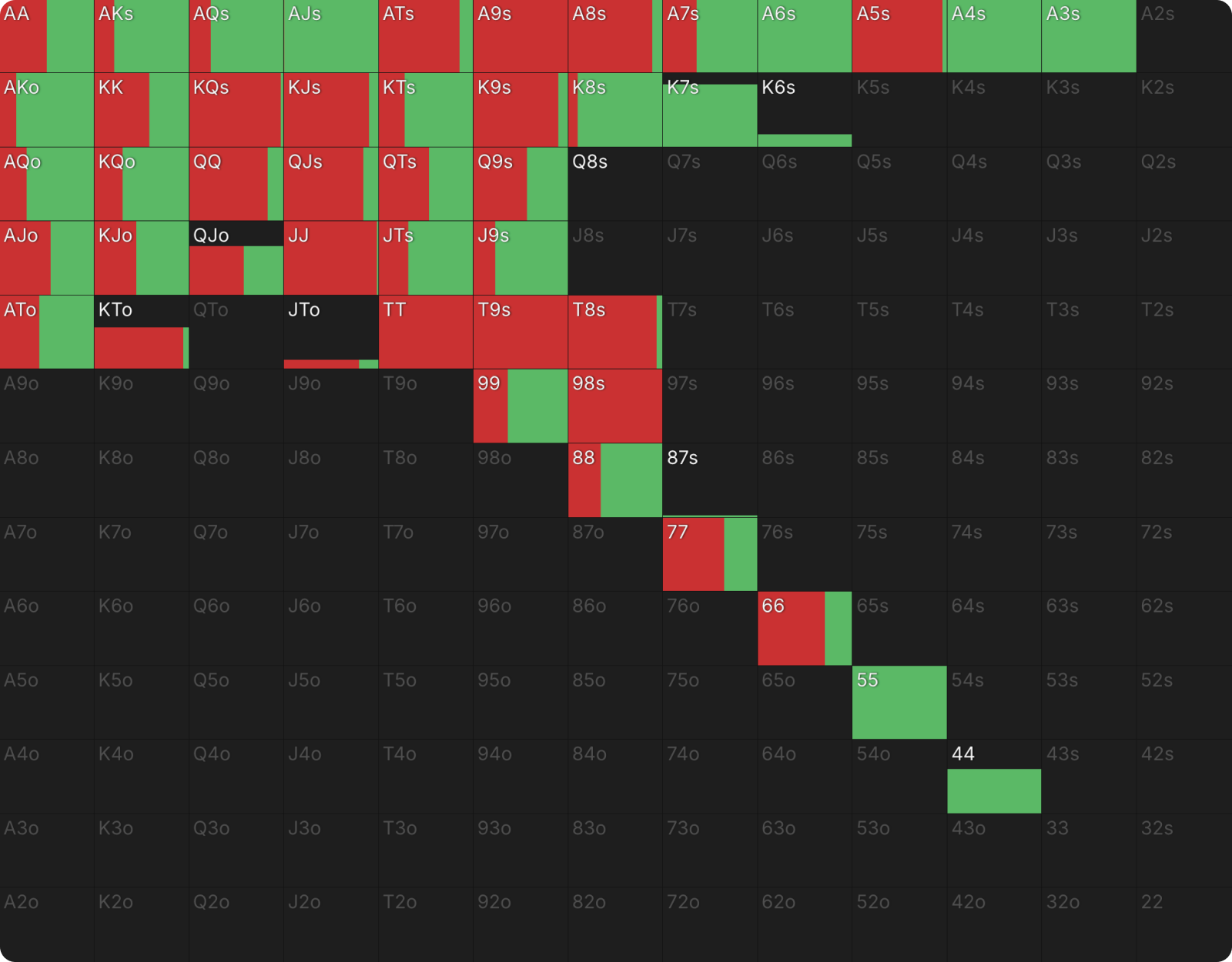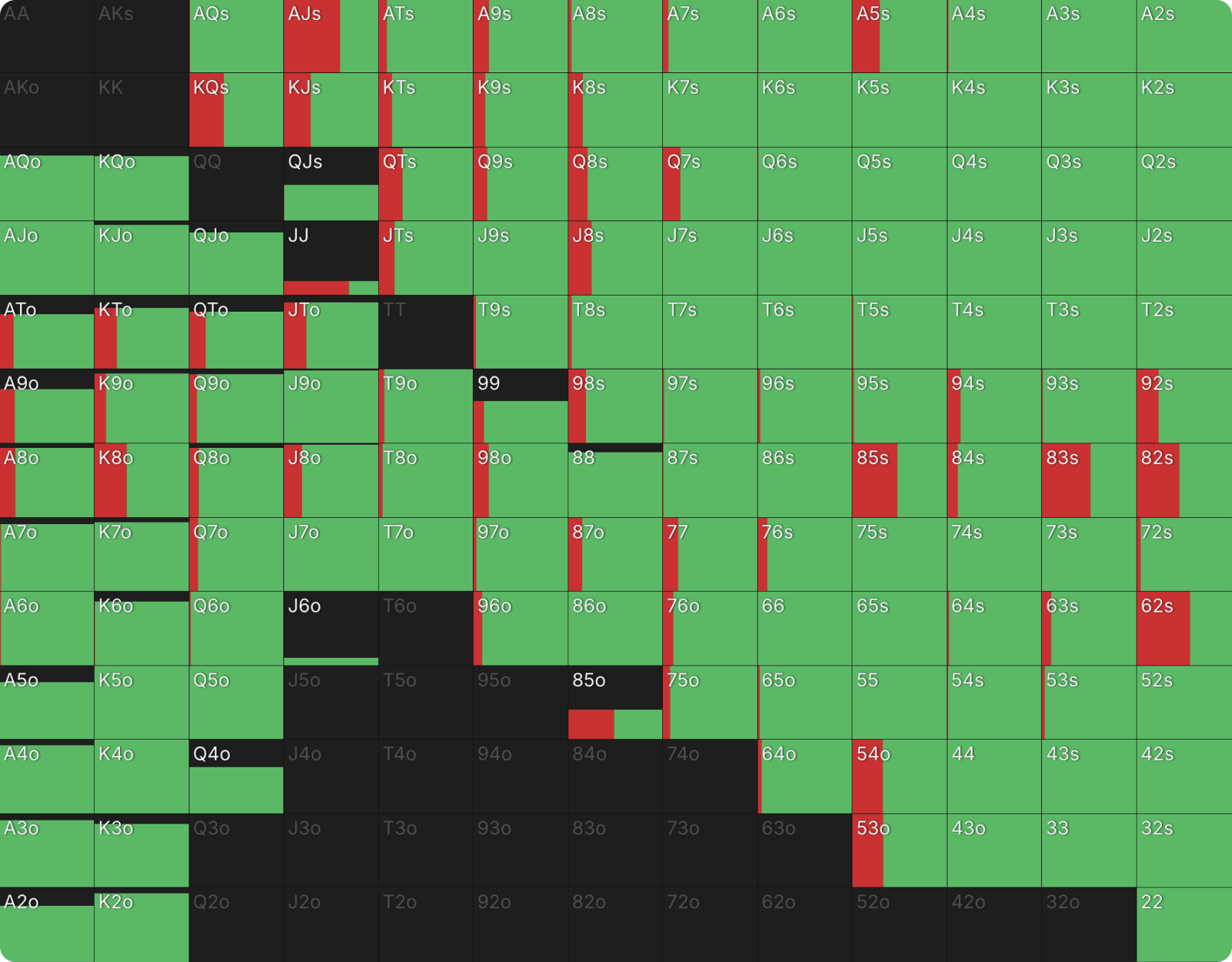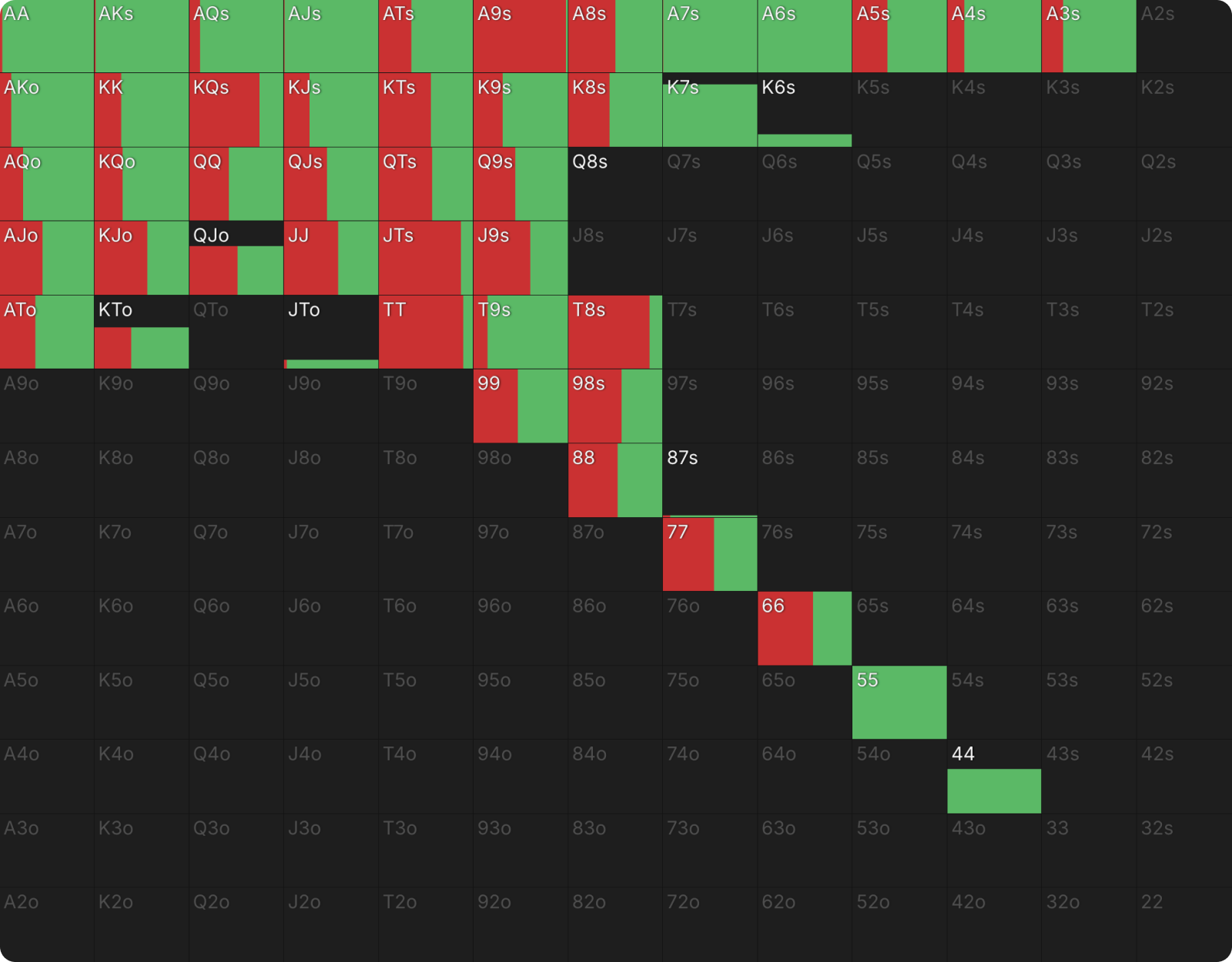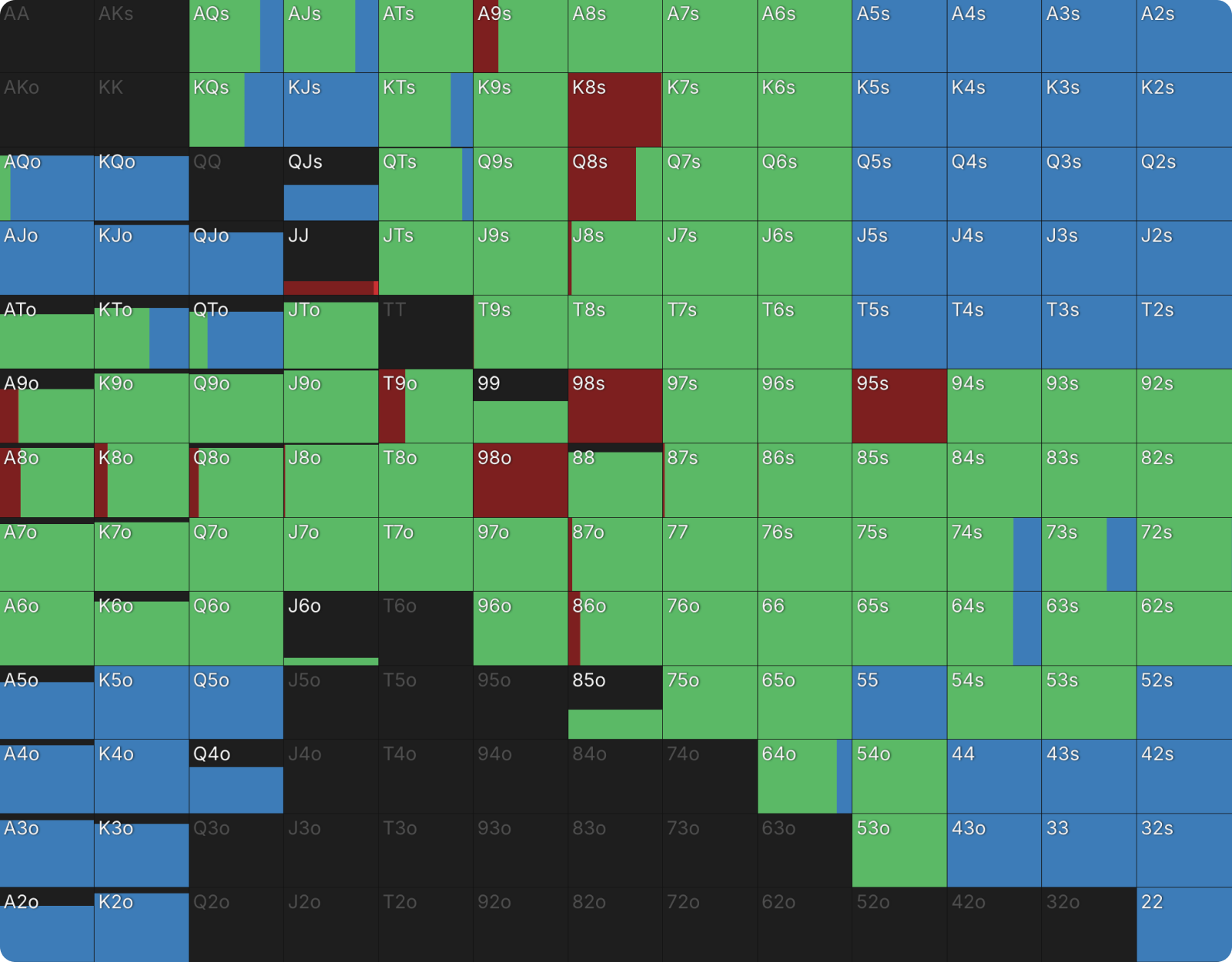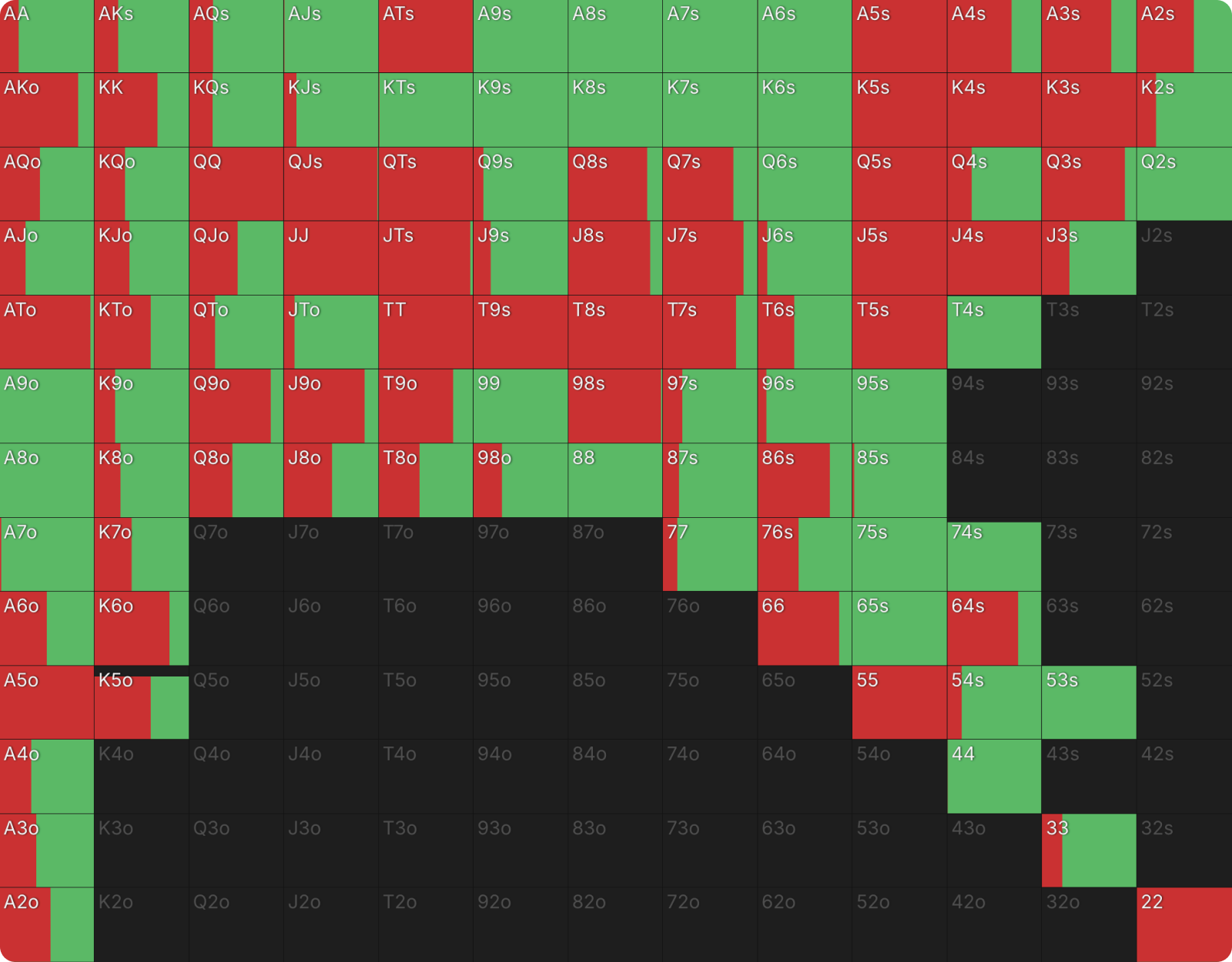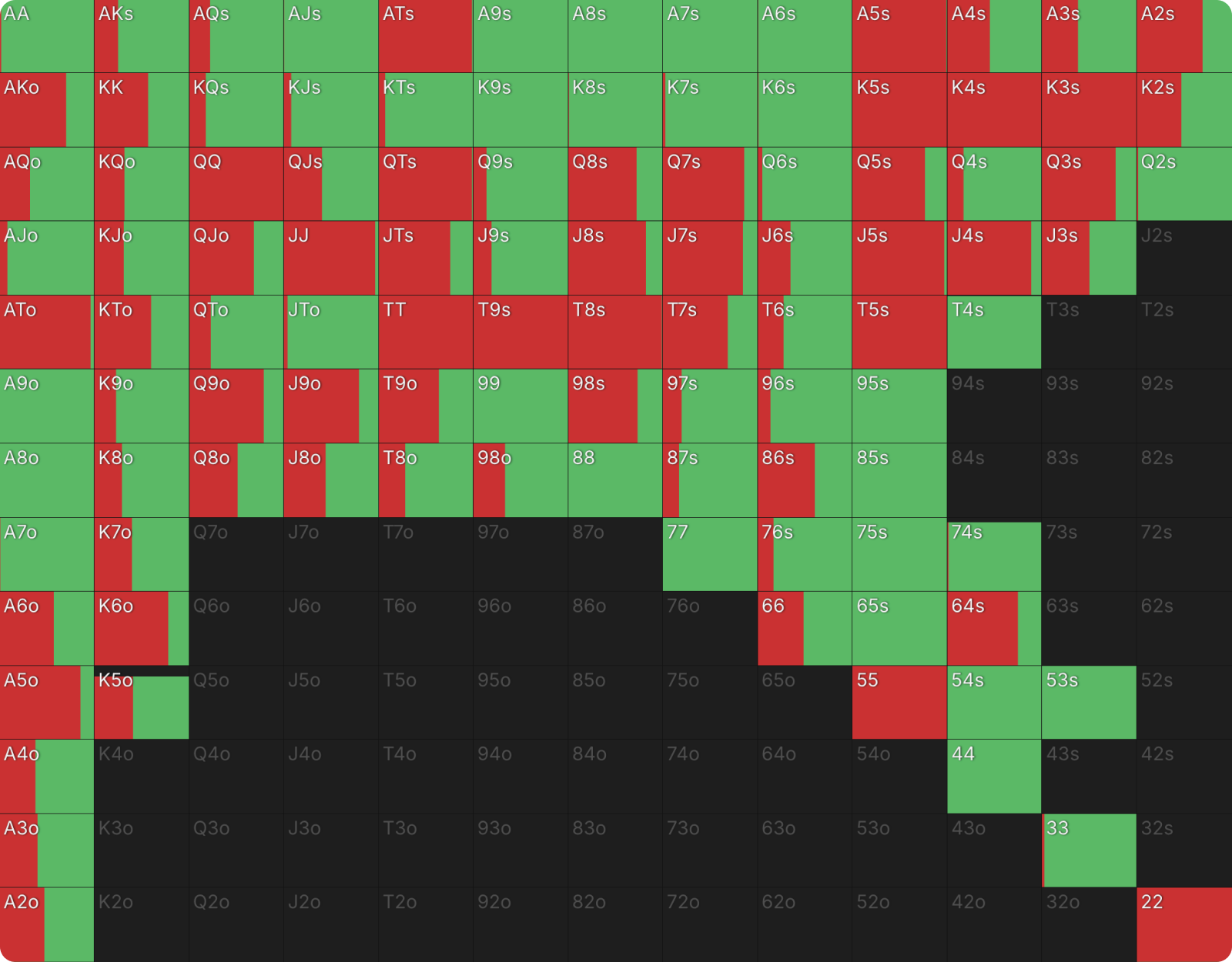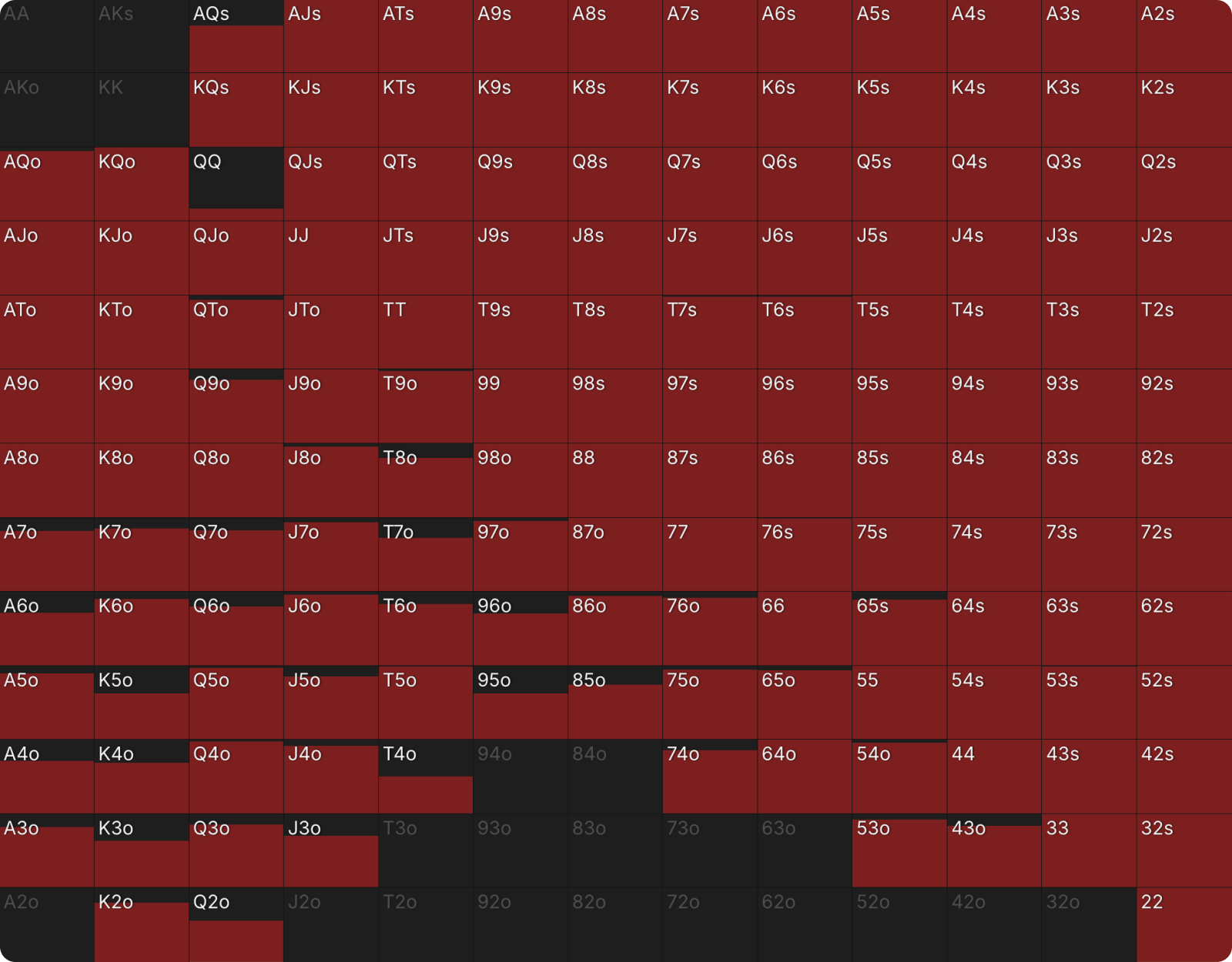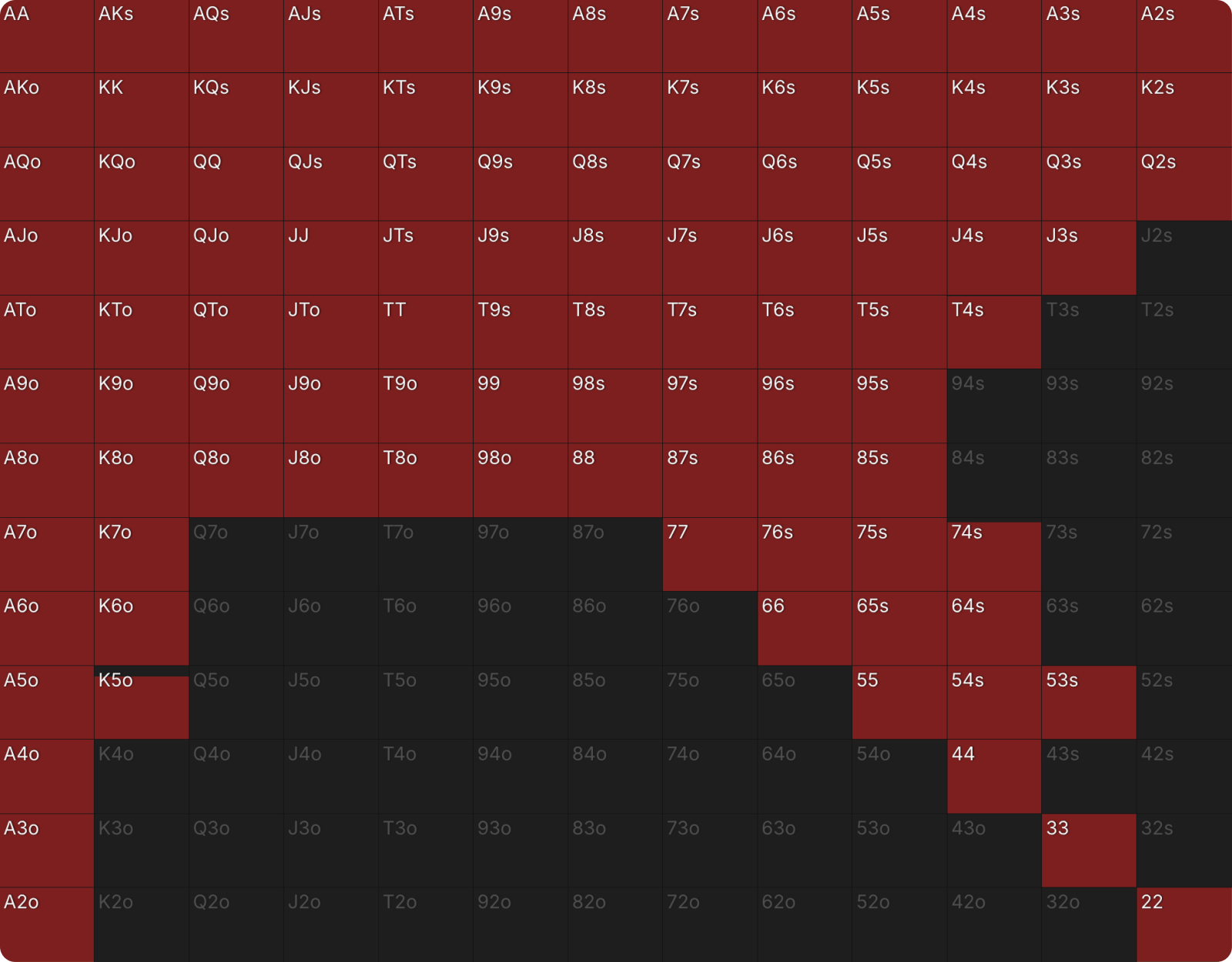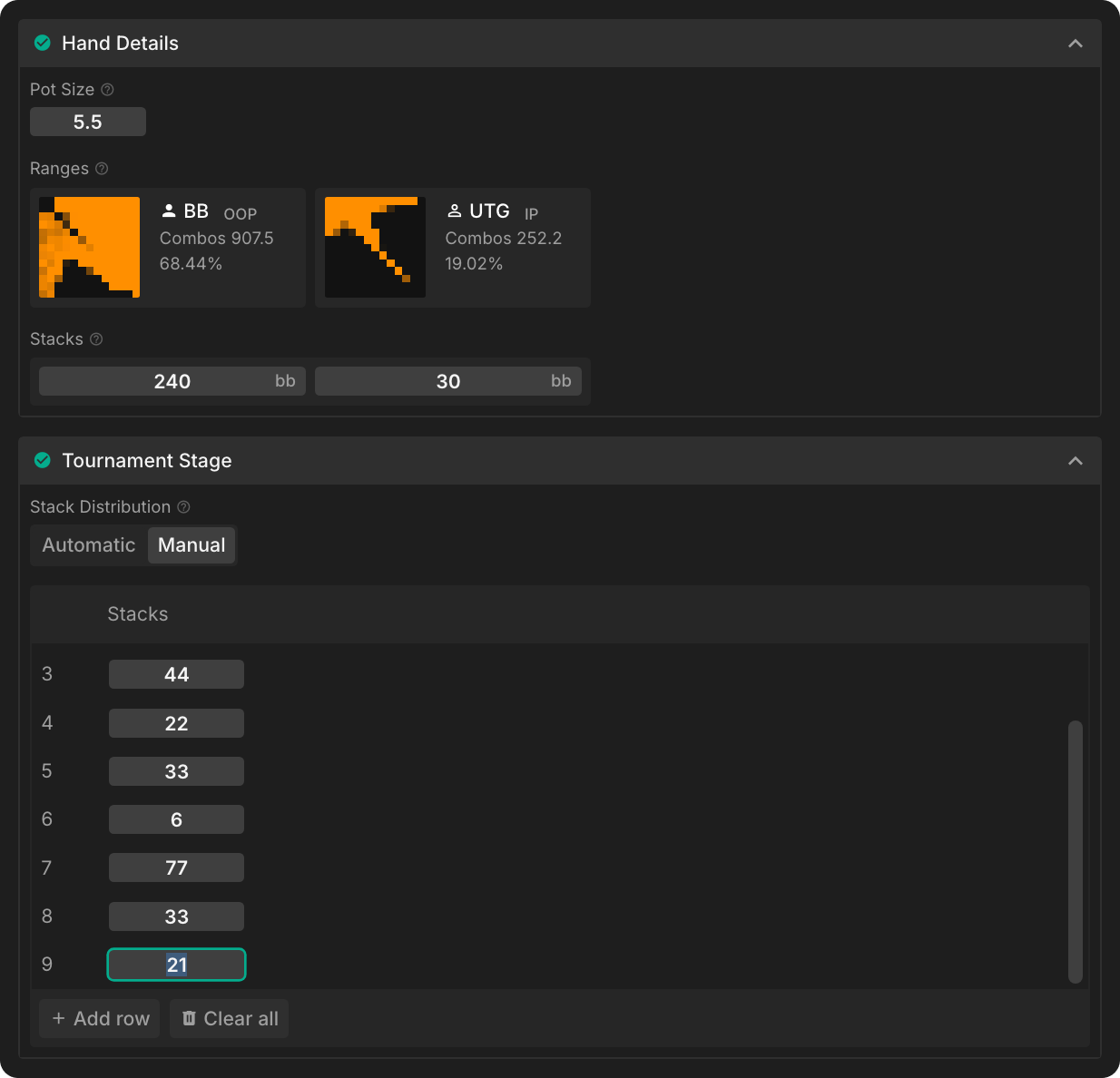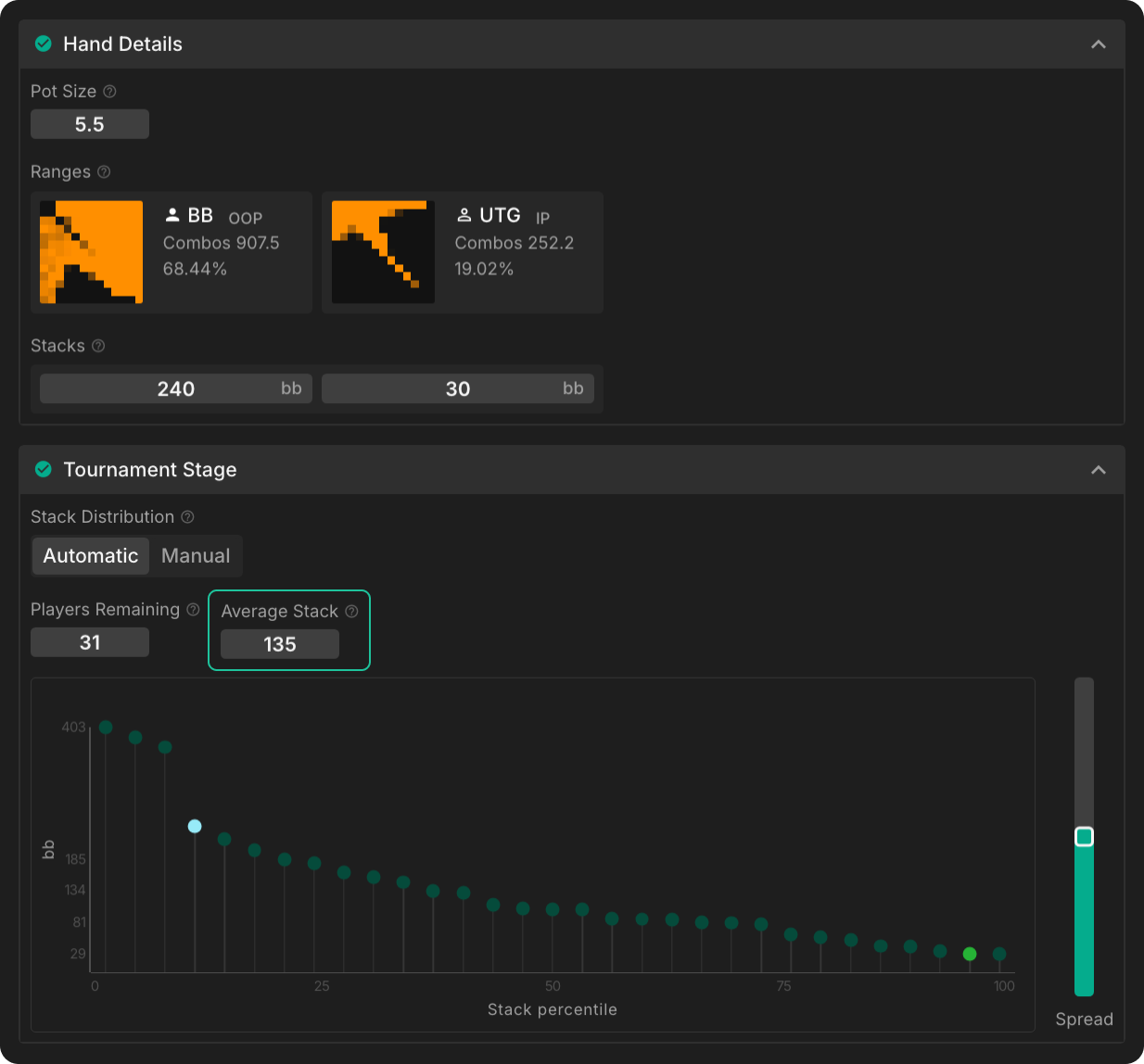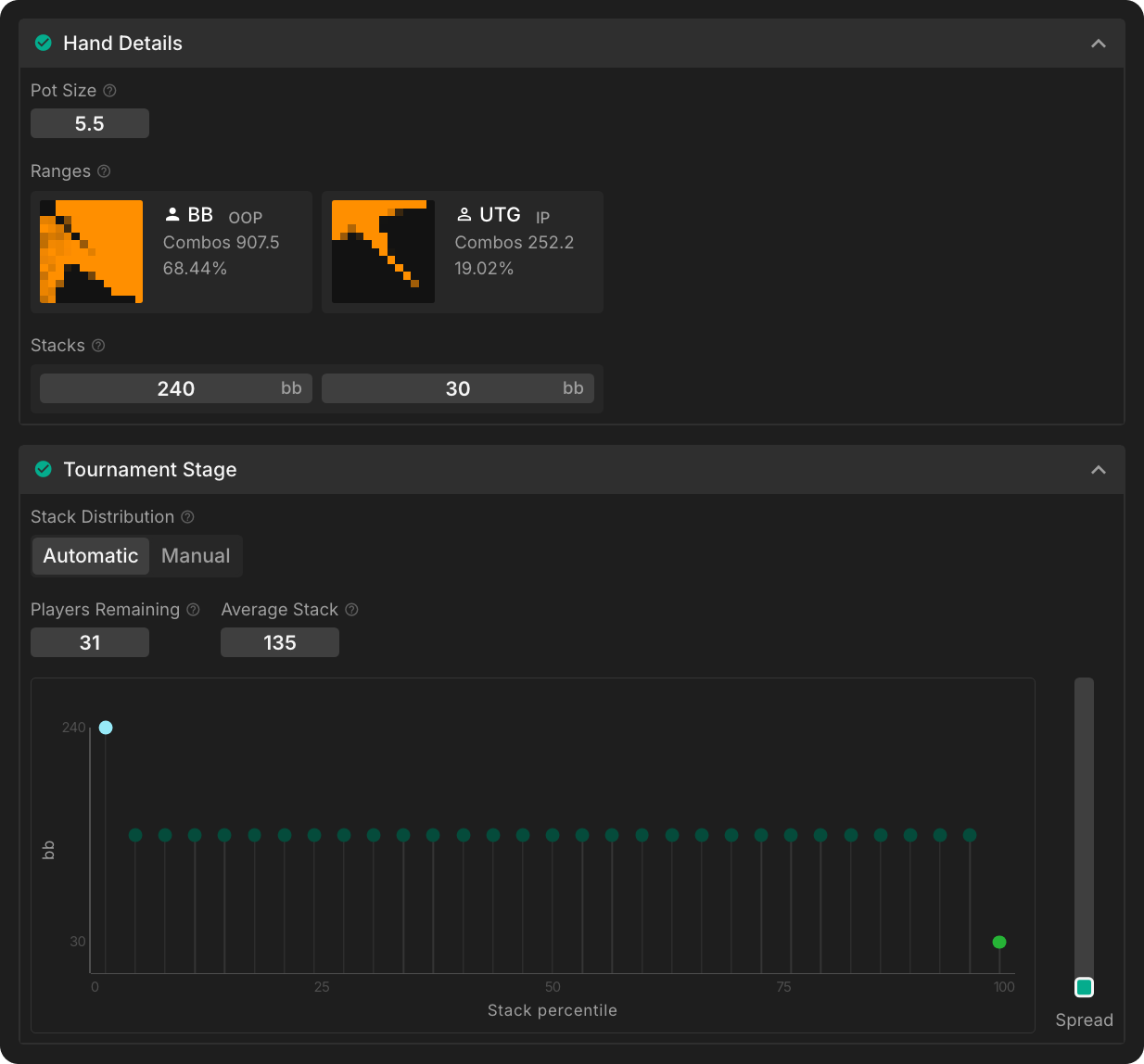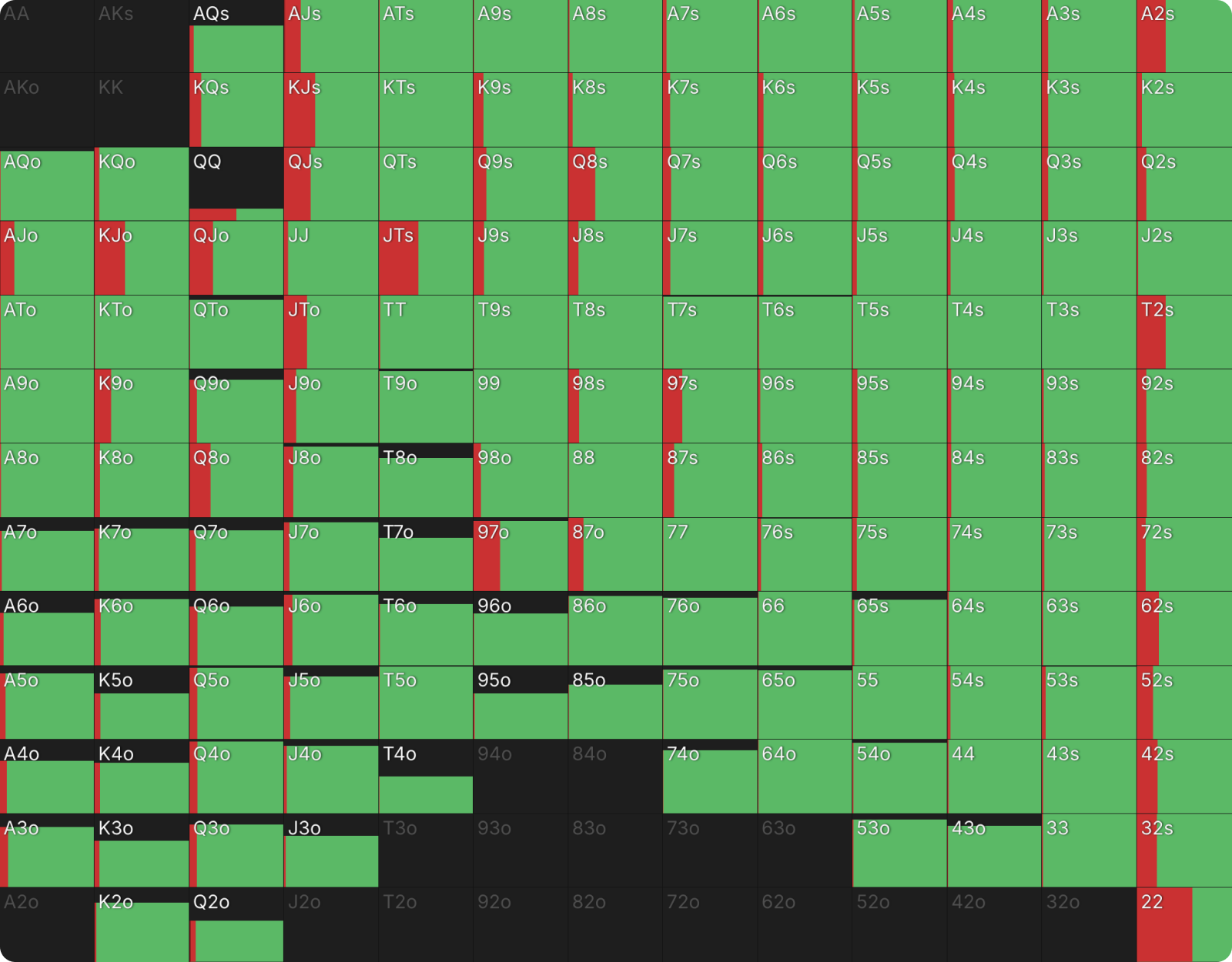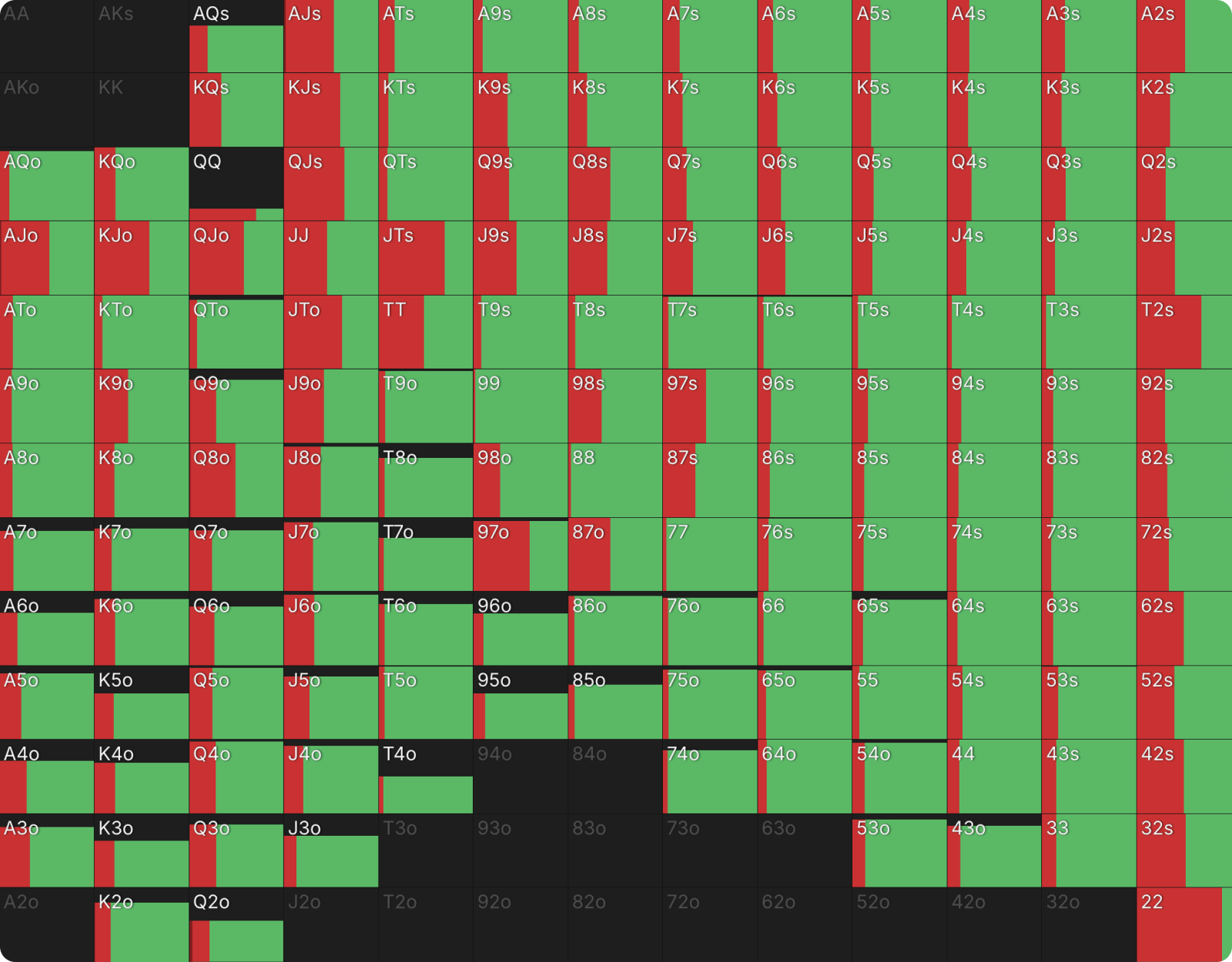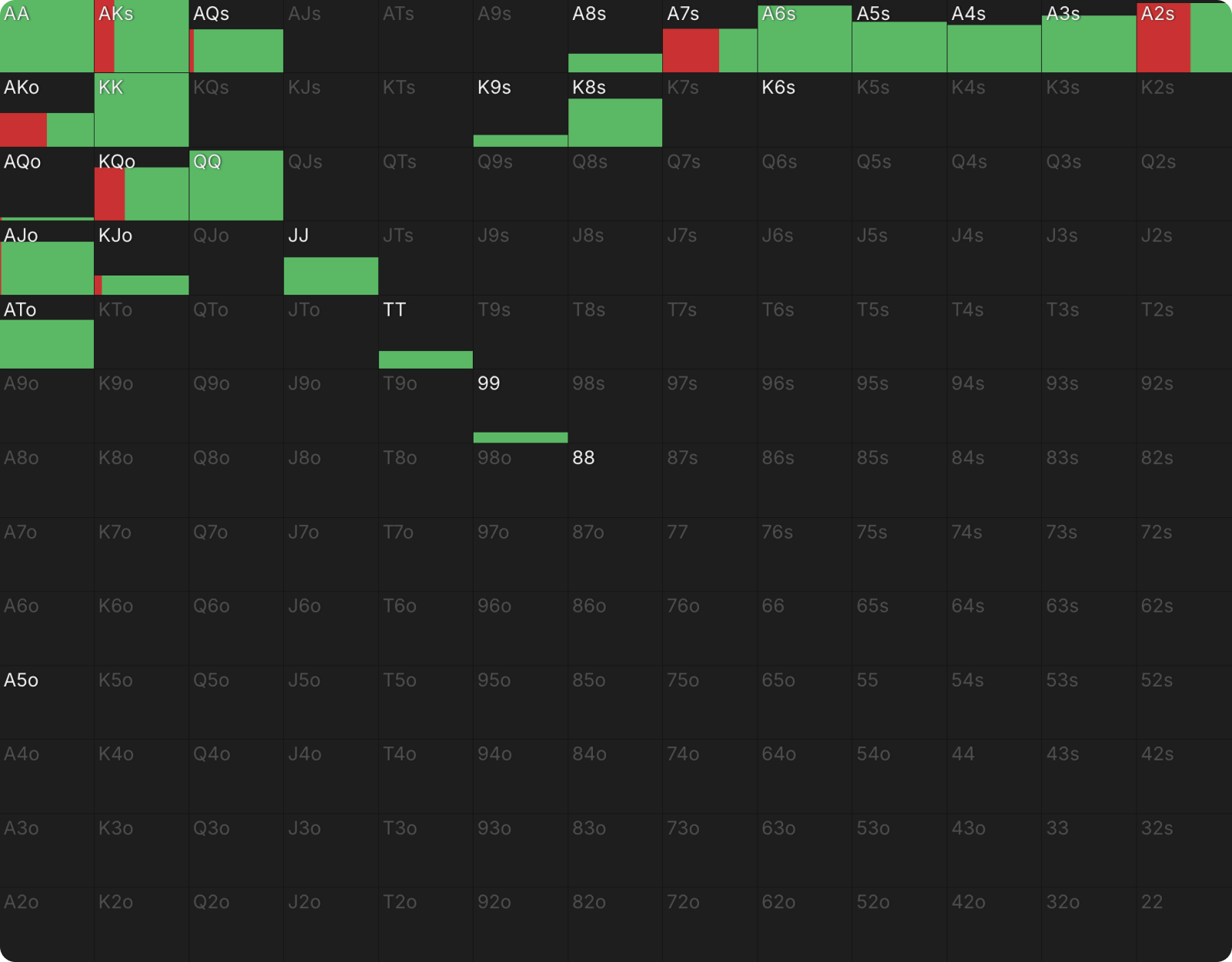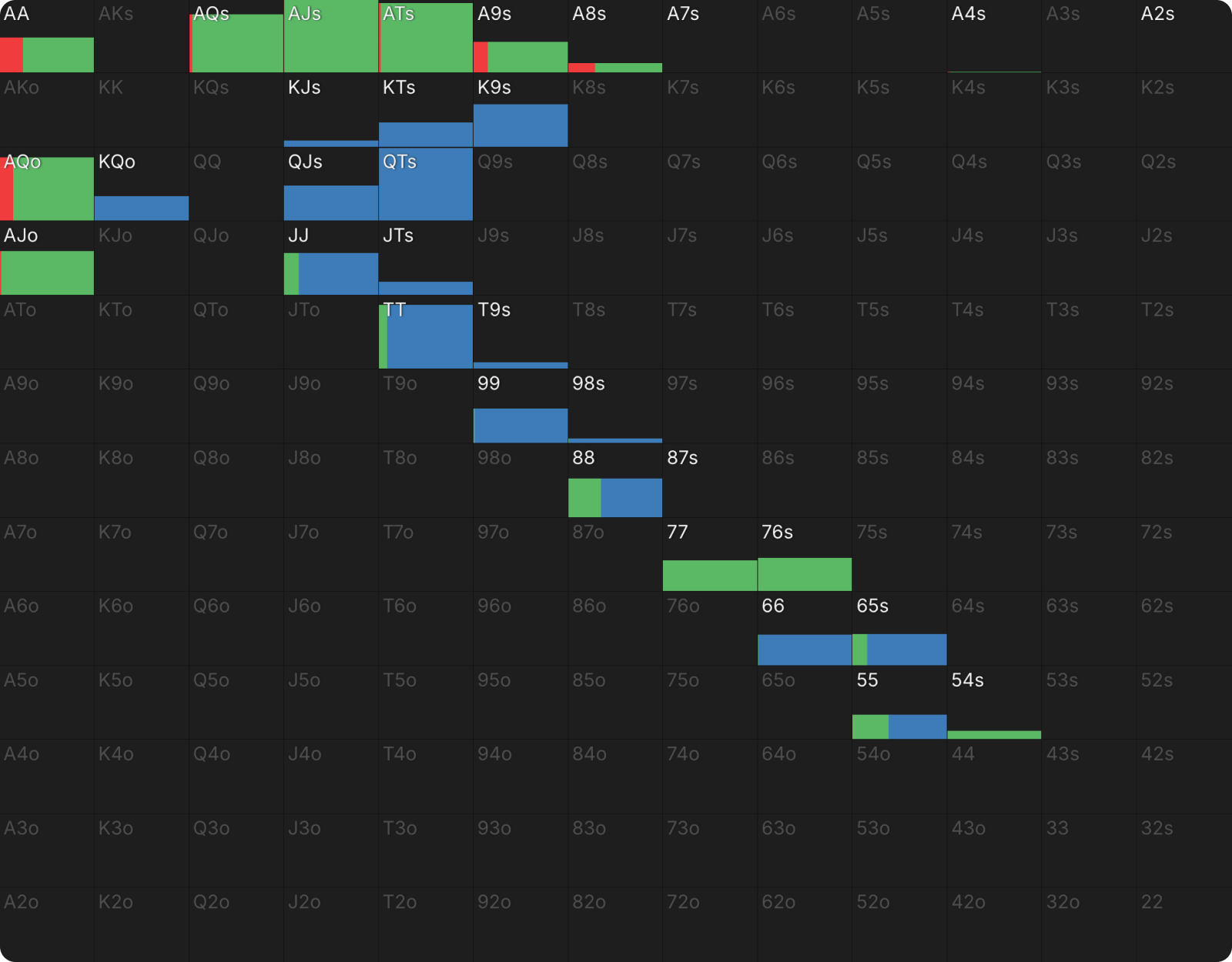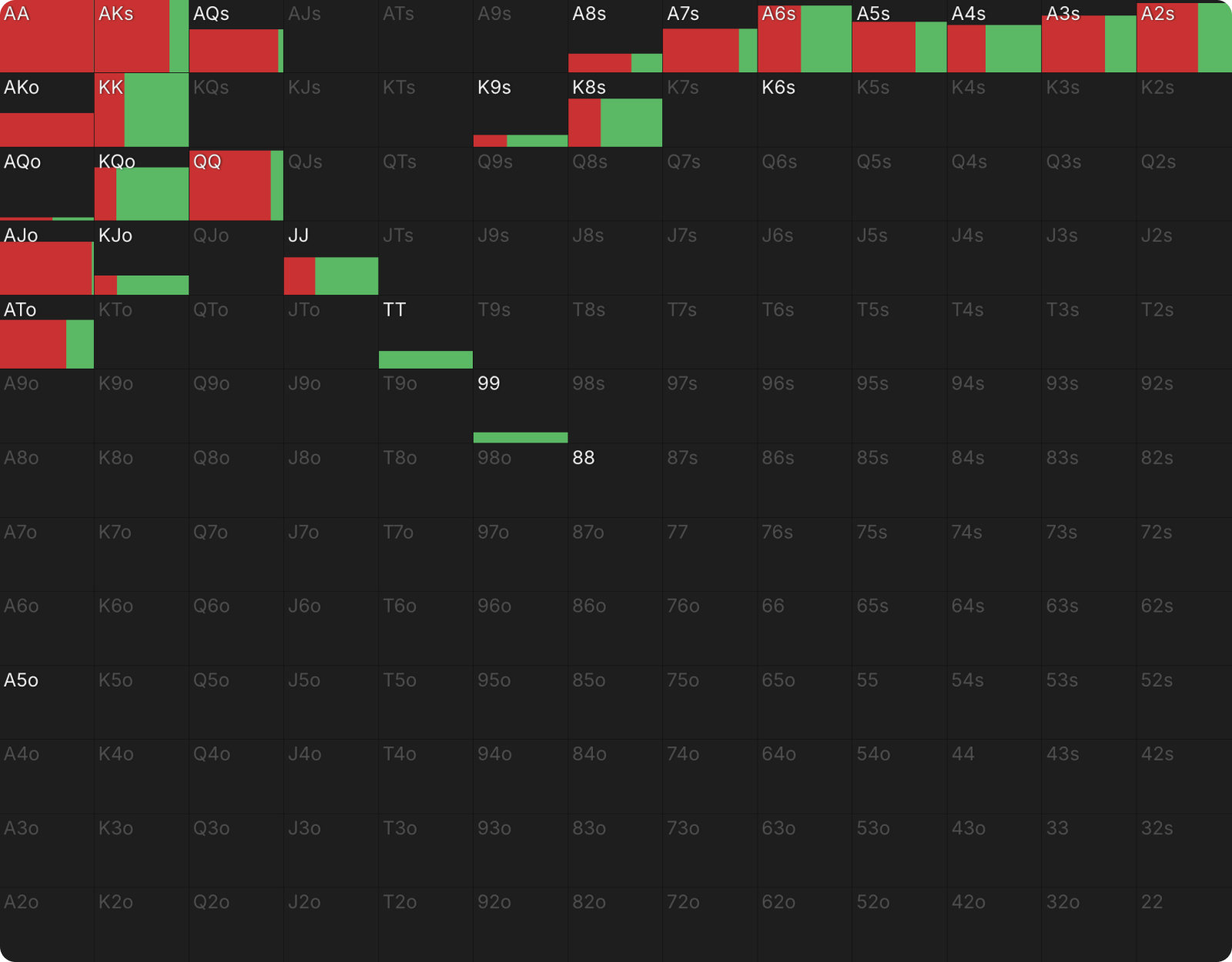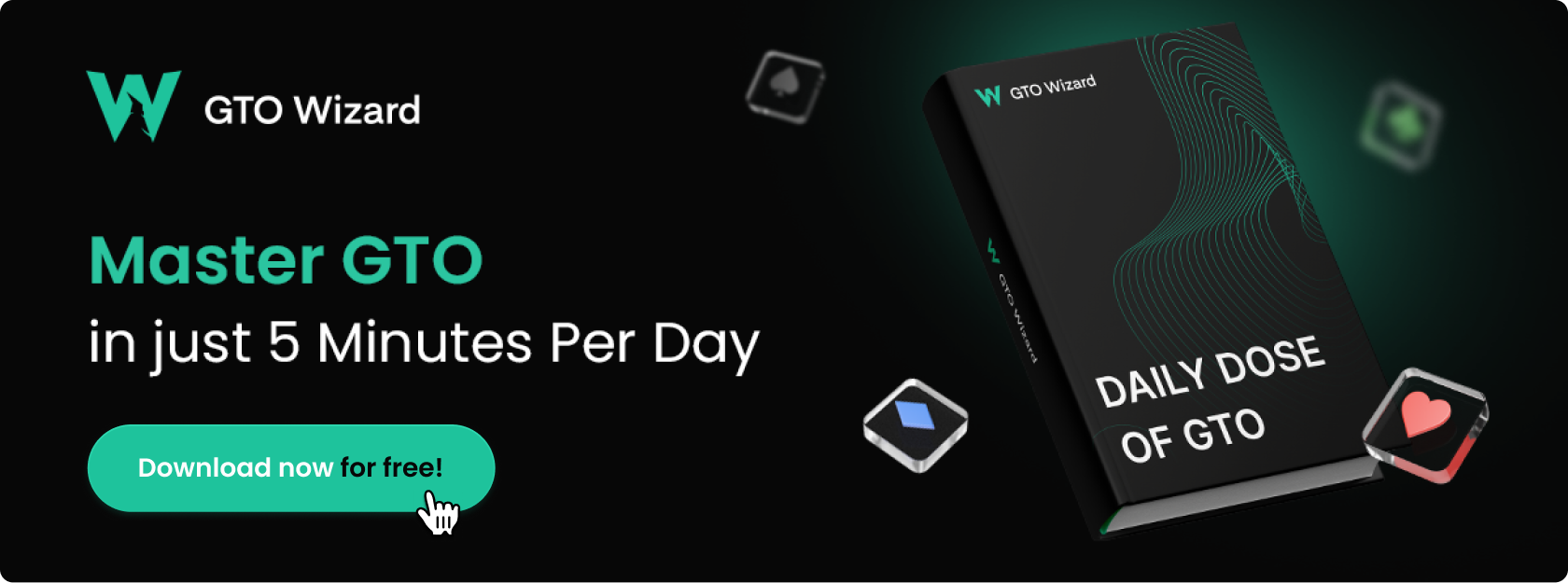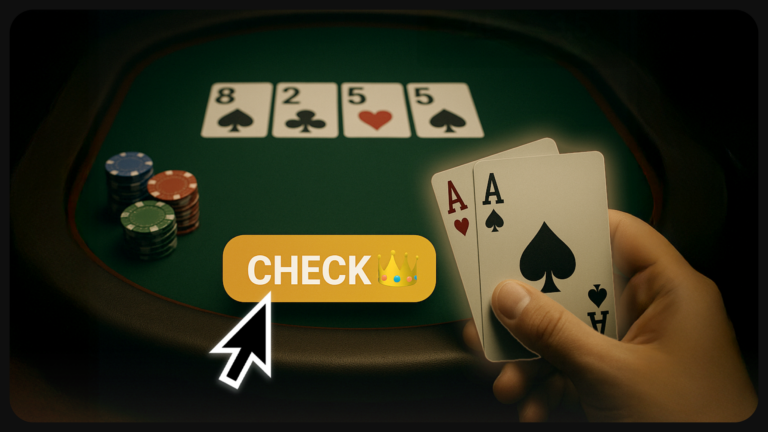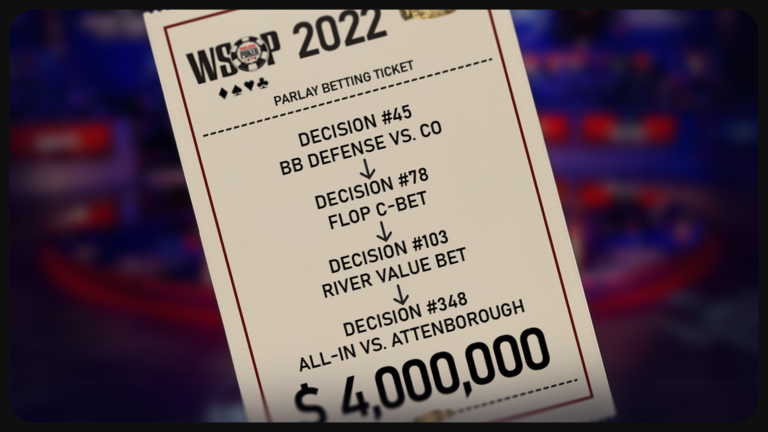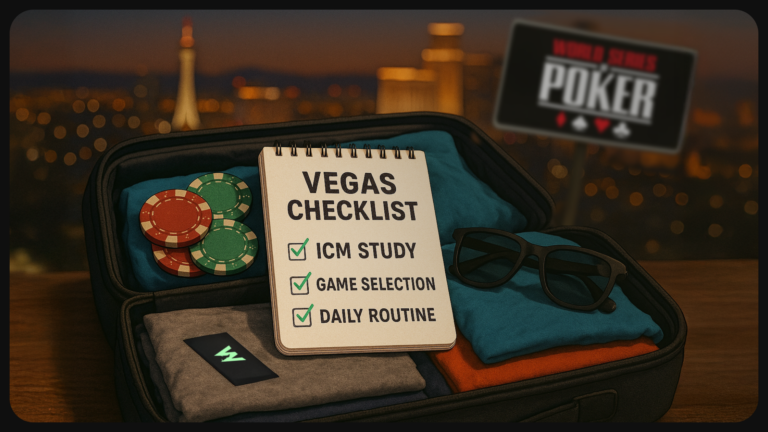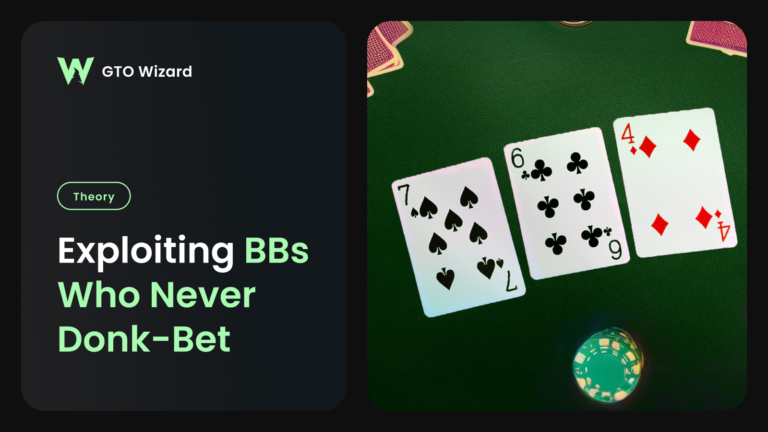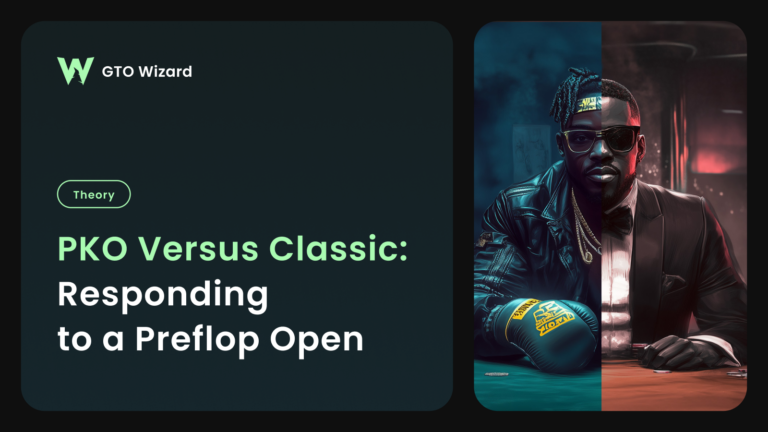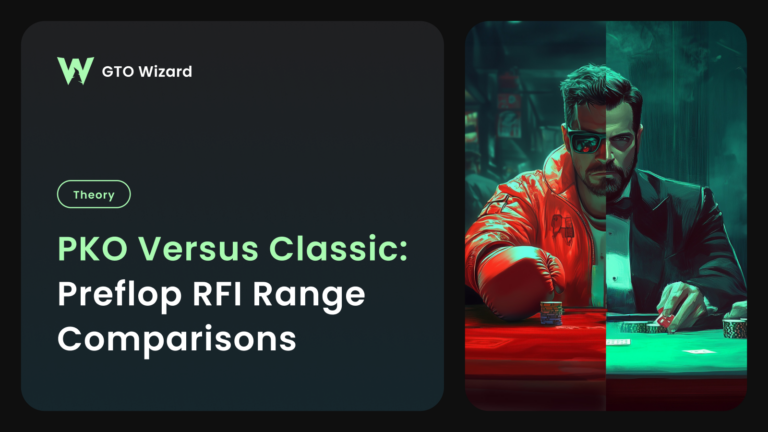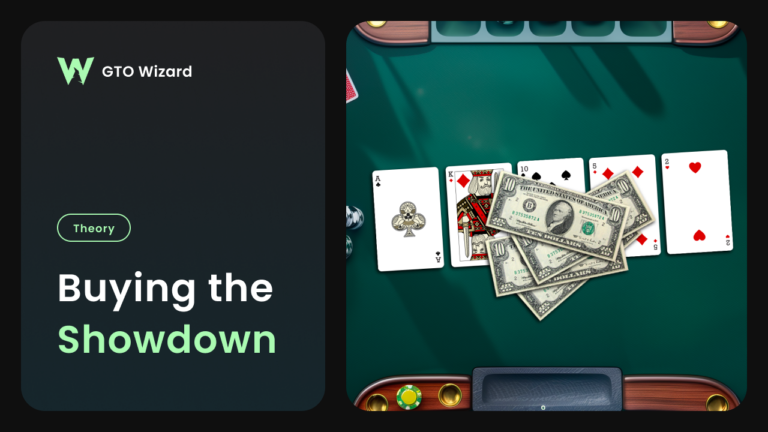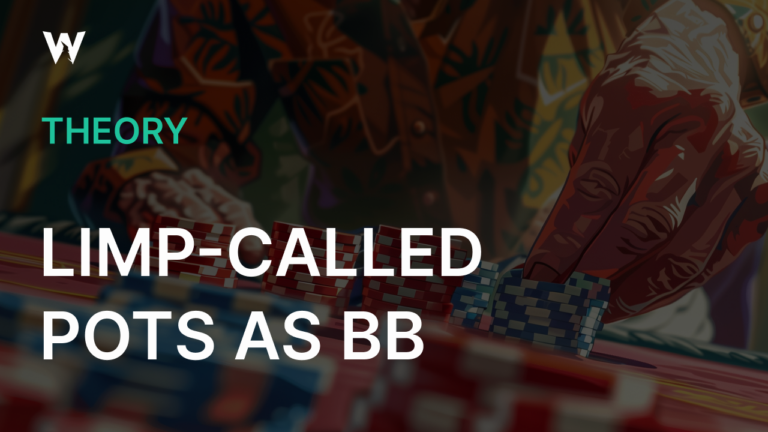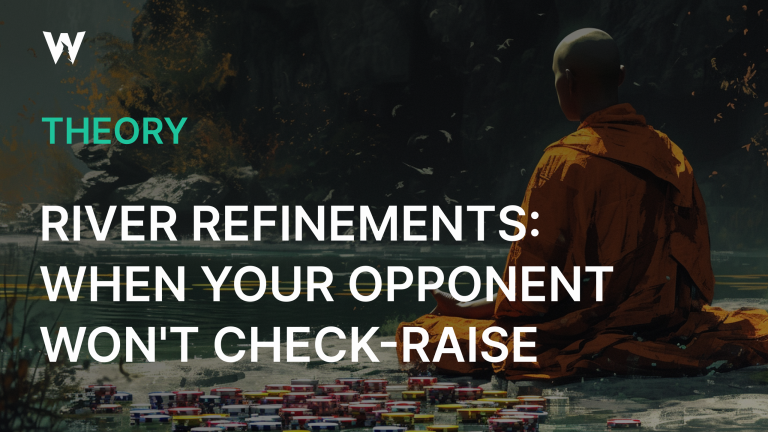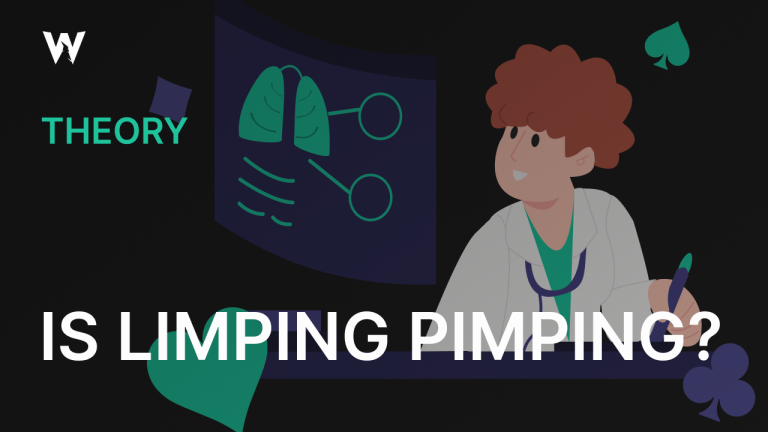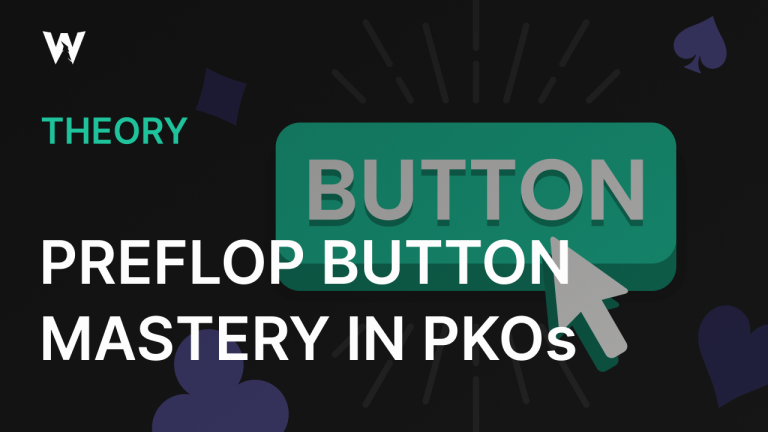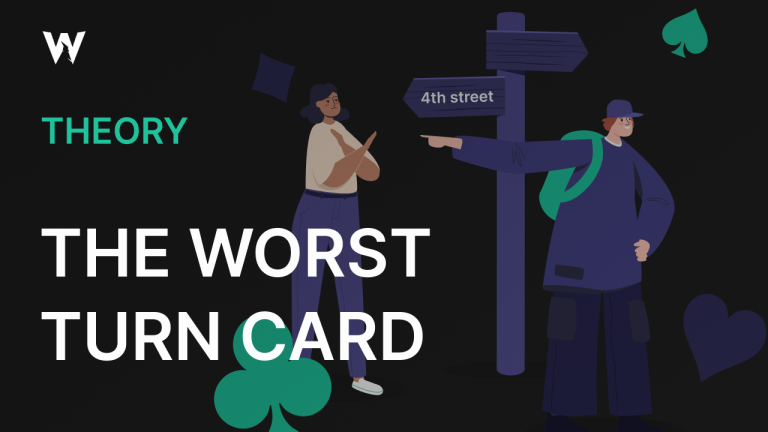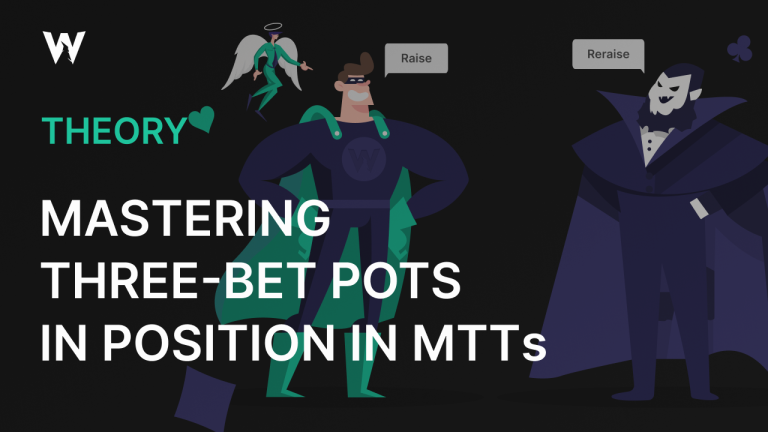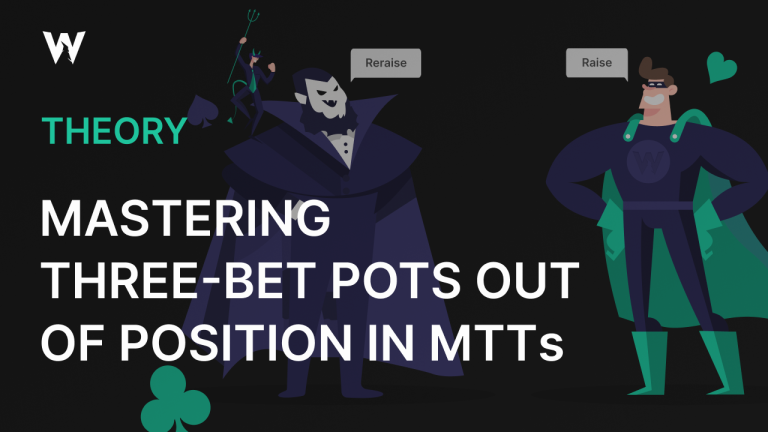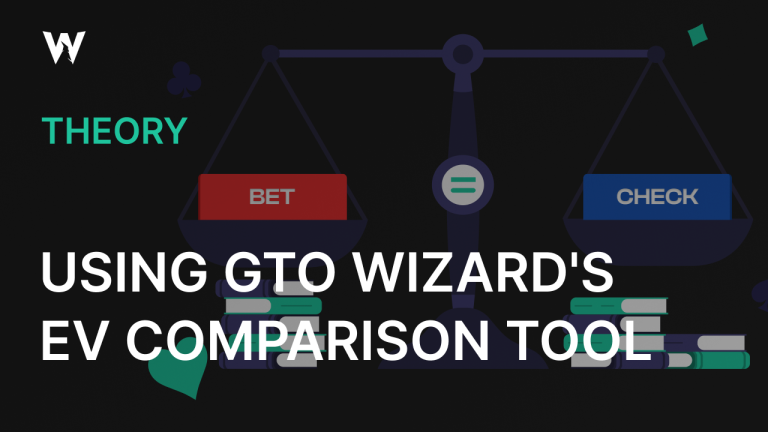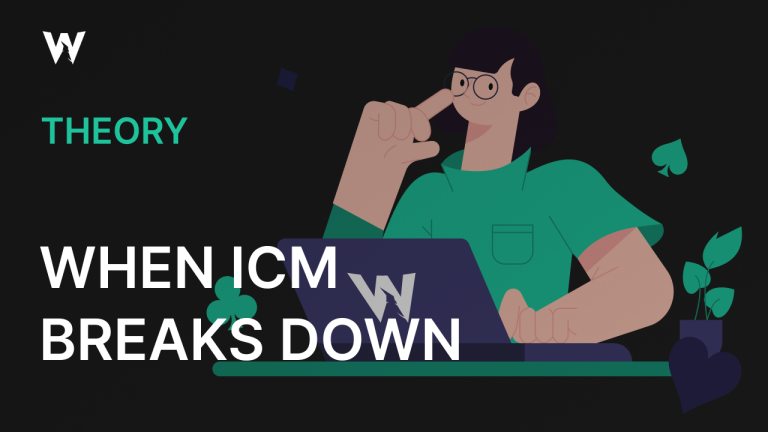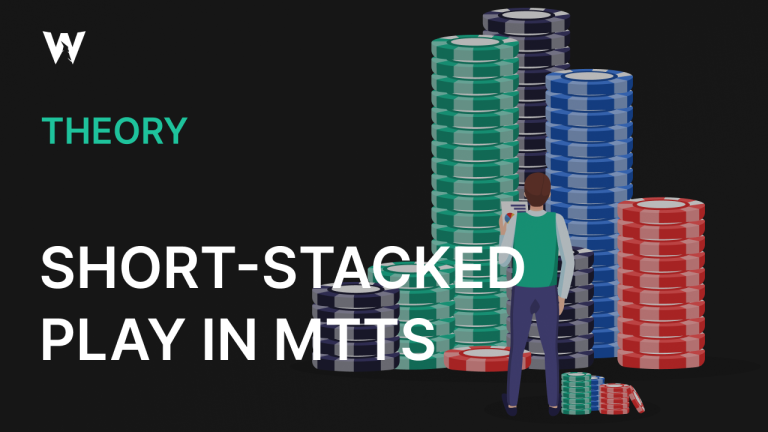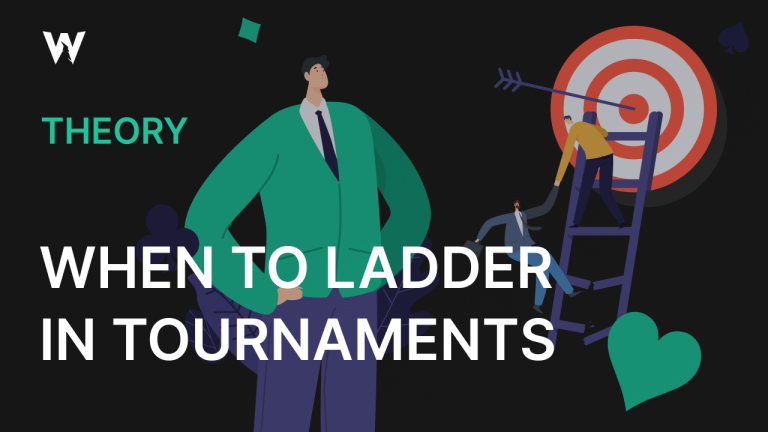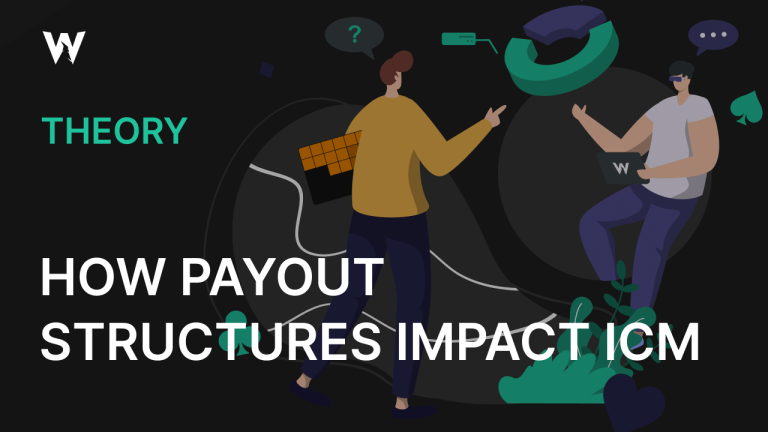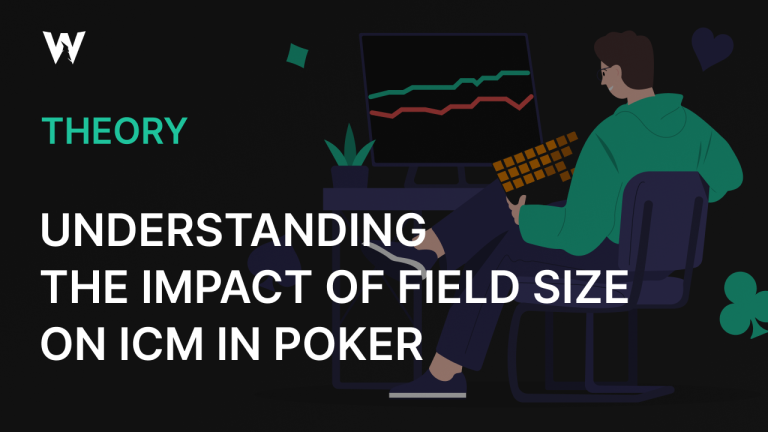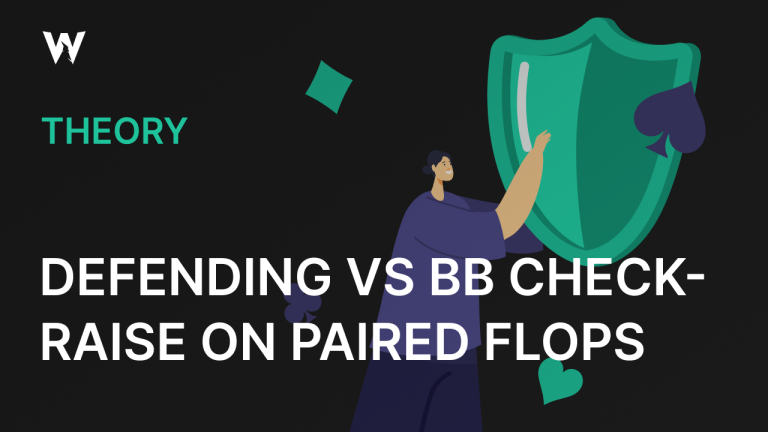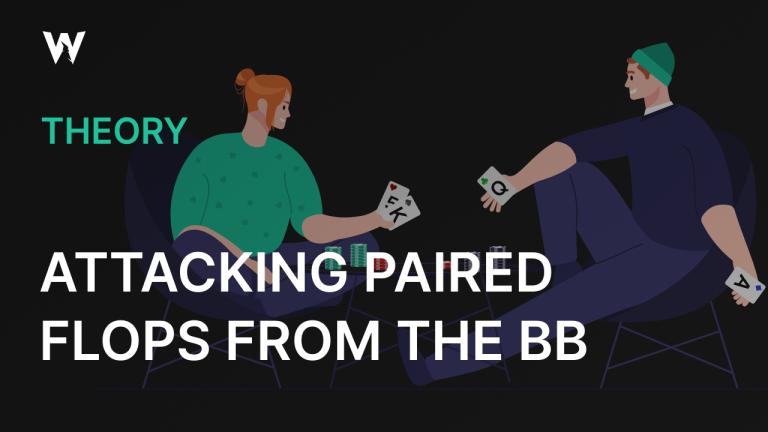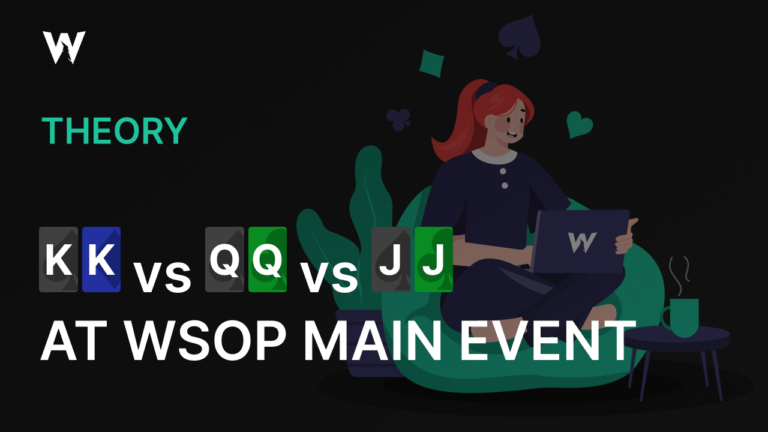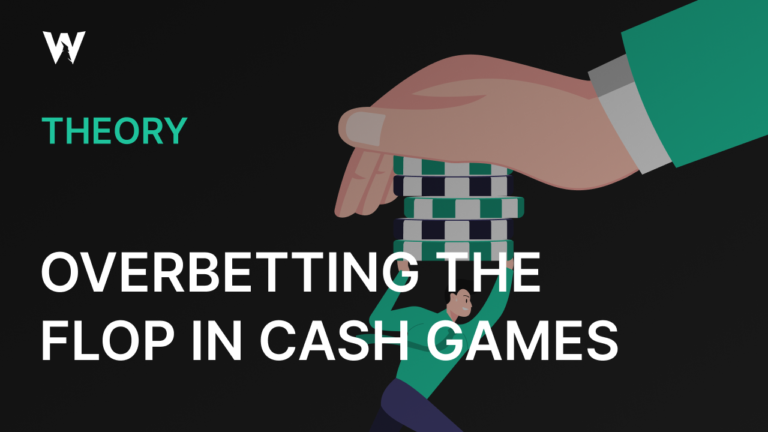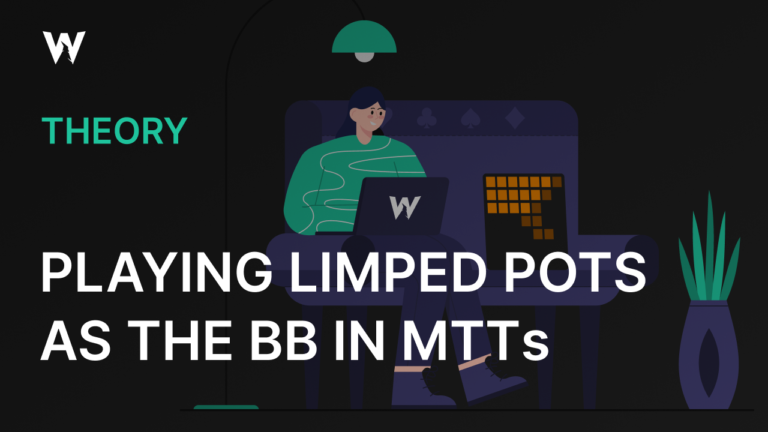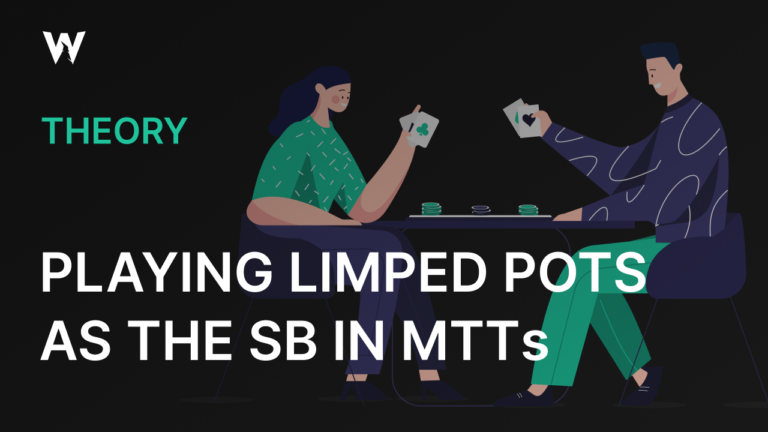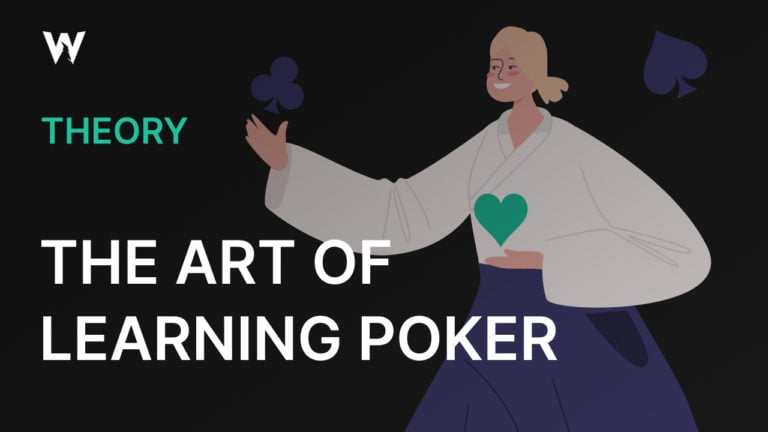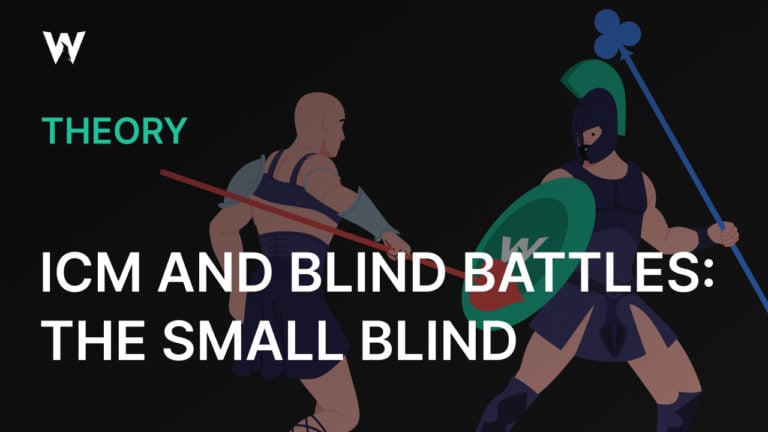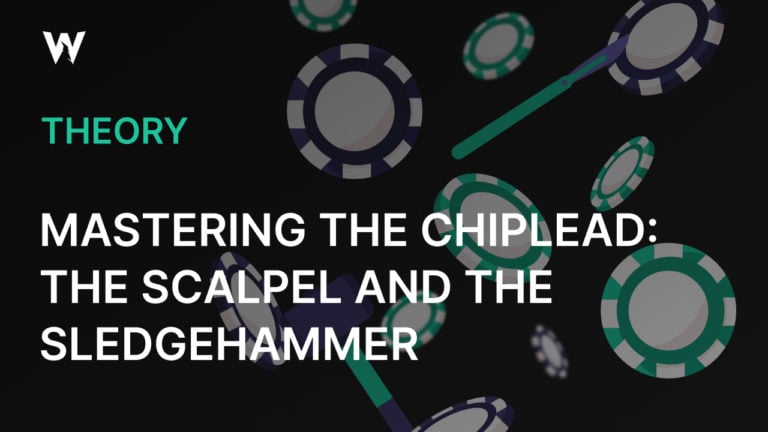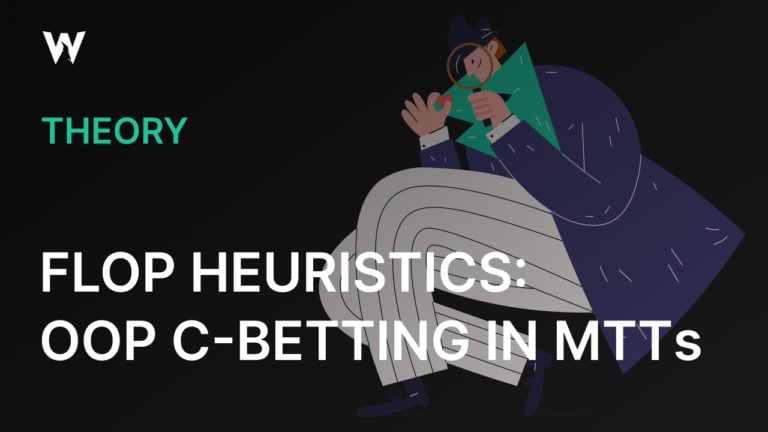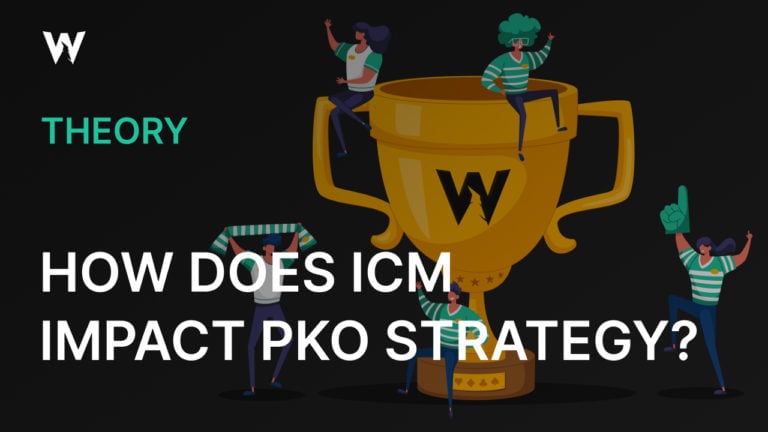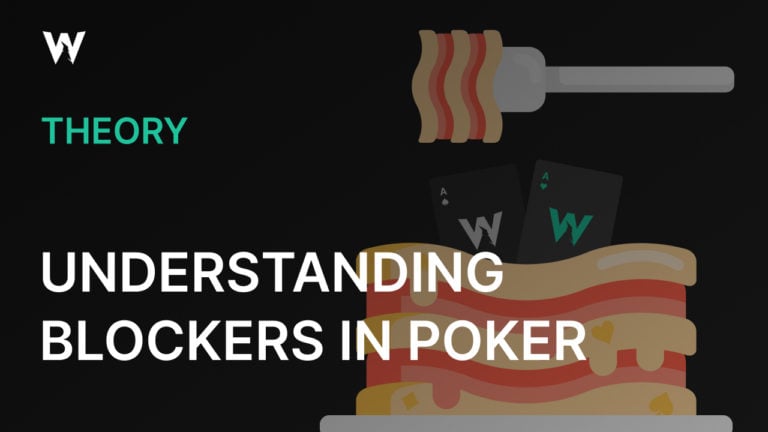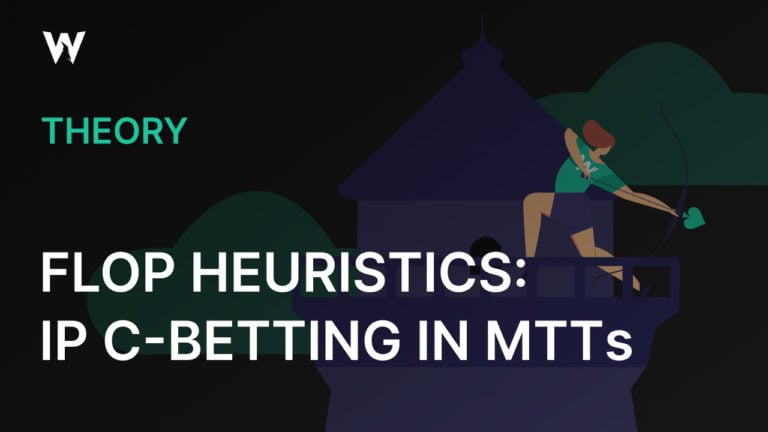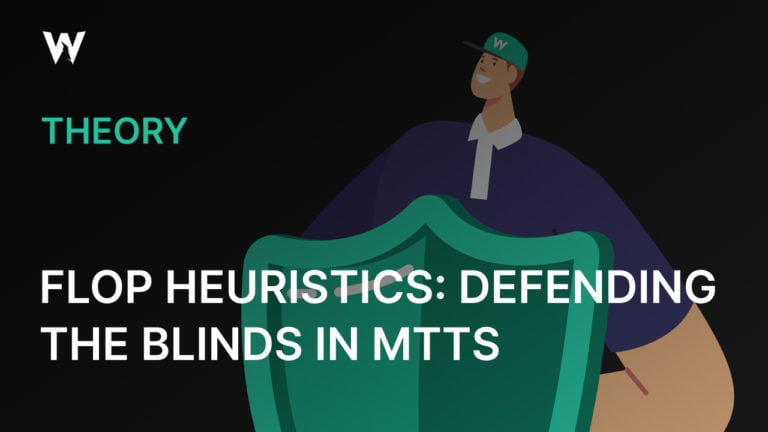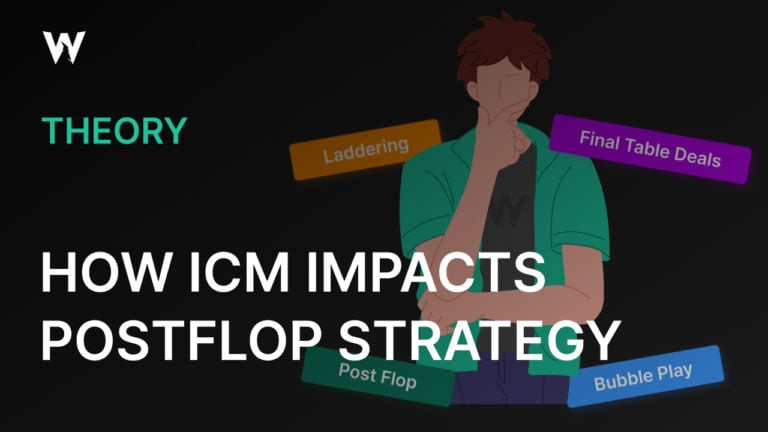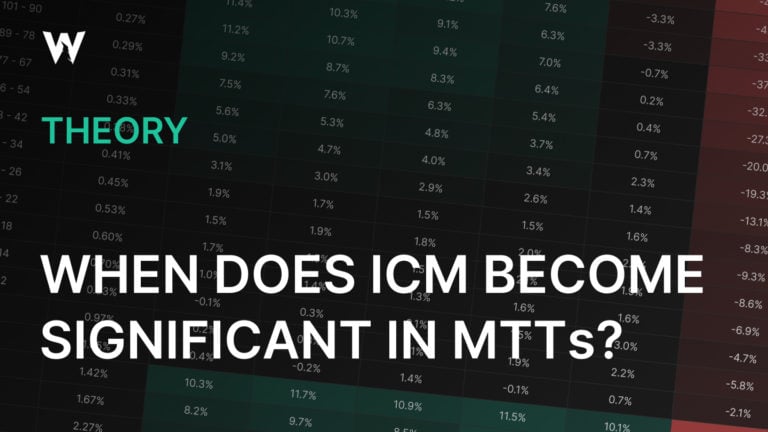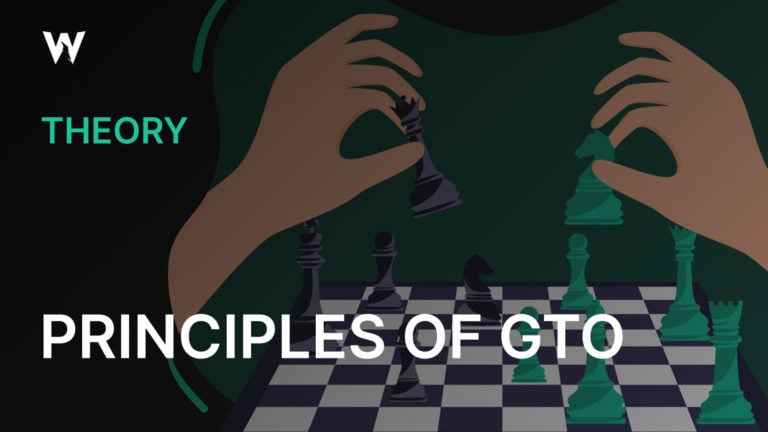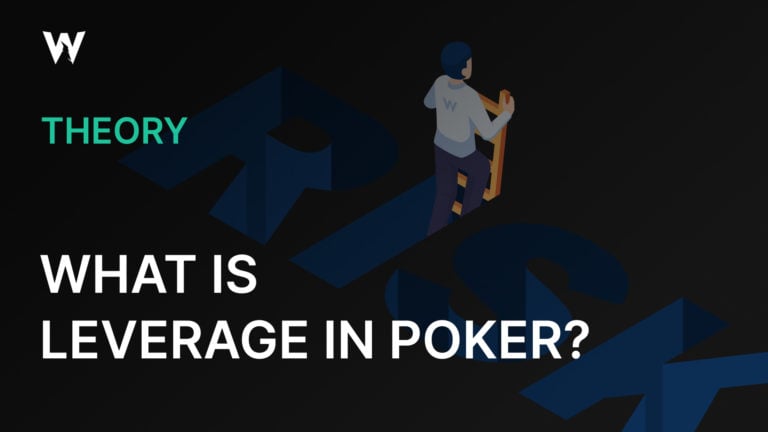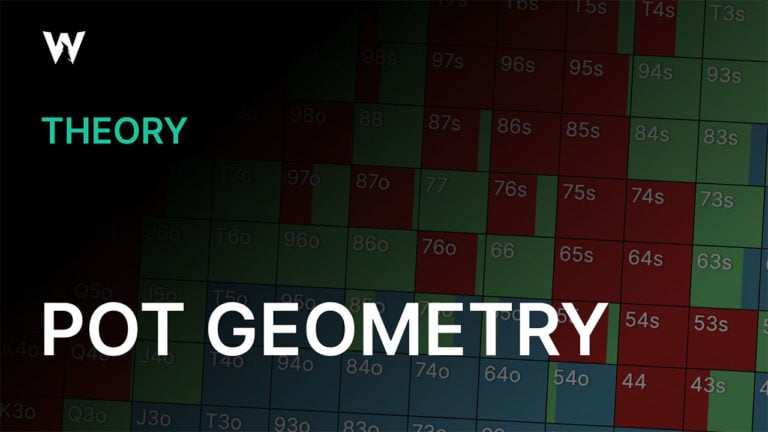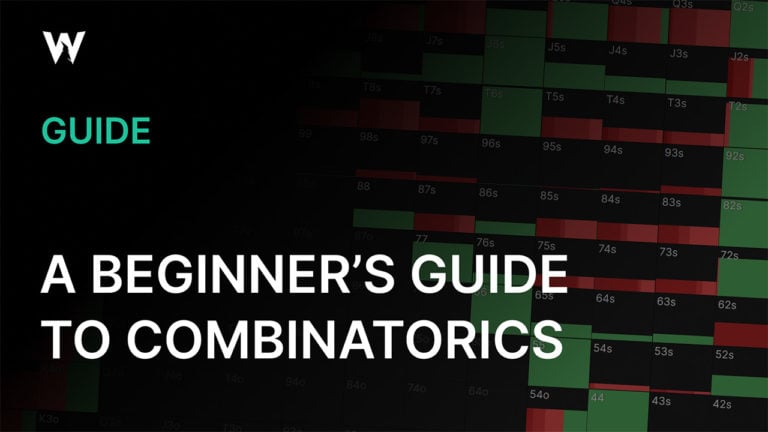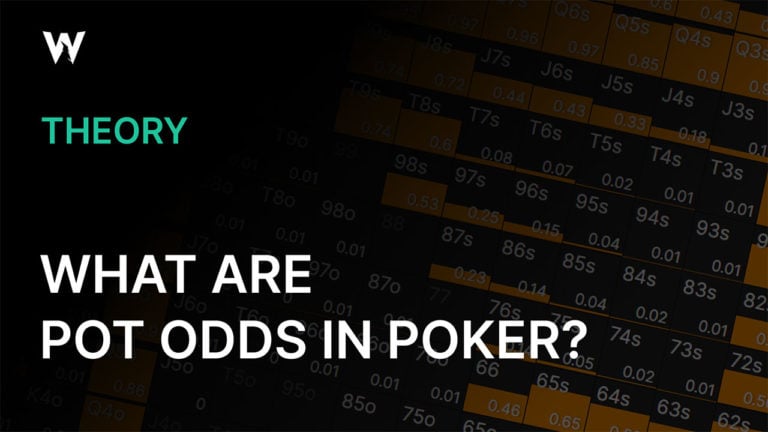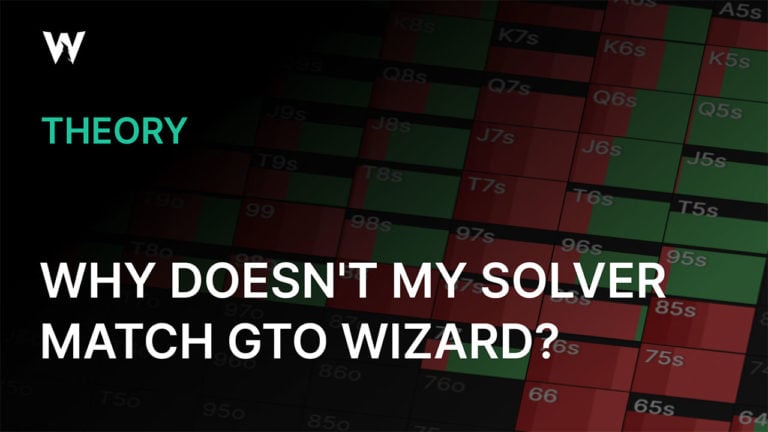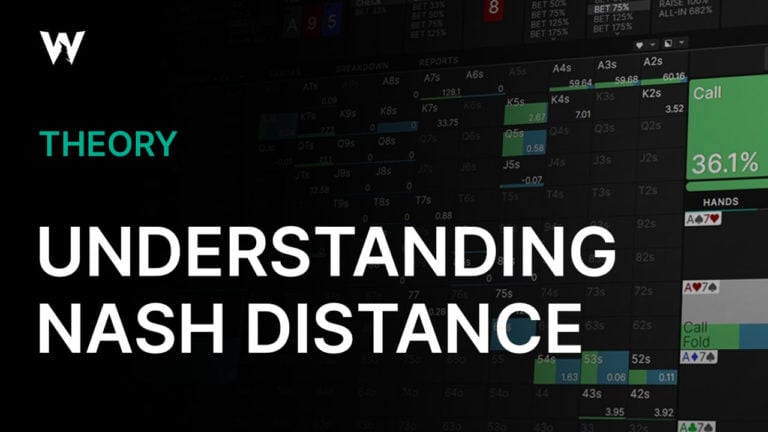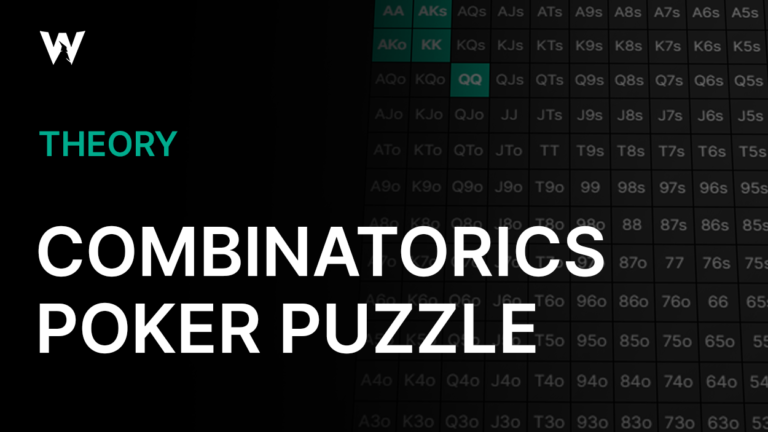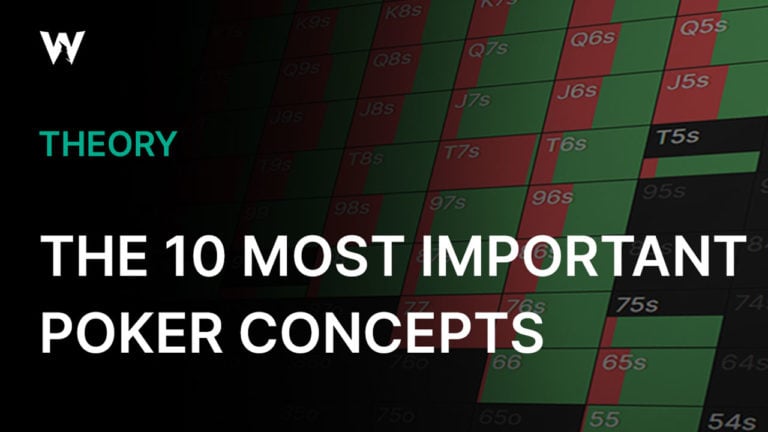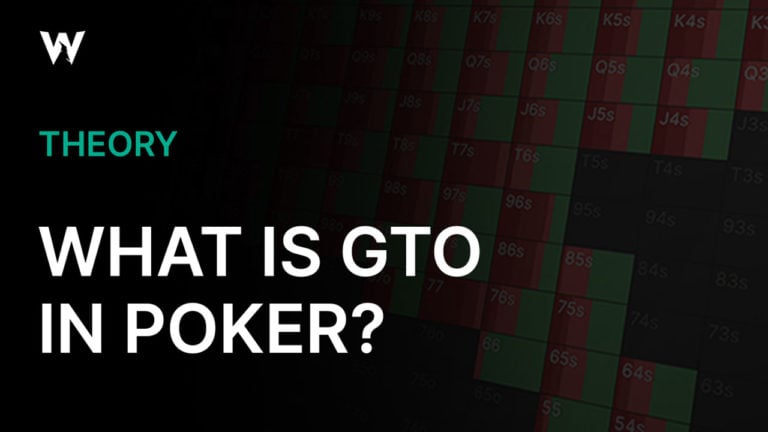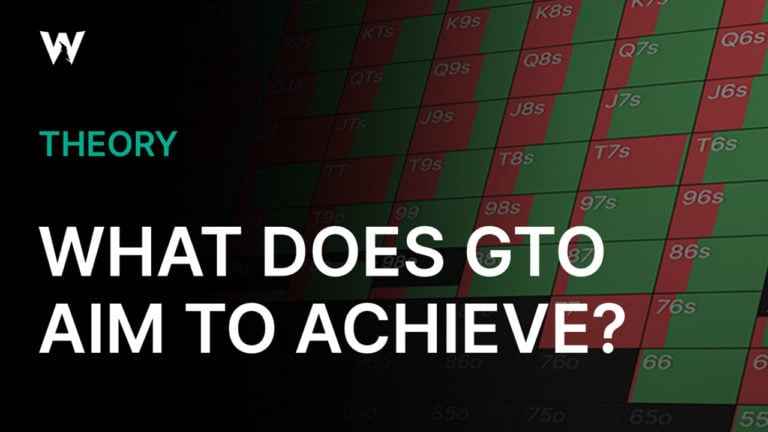Mastering Postflop ICM: Avoid These Common Mistakes
The new postflop ICM feature from GTO Wizard is a game changer. Previous incarnations of postflop ICM solvers have been challenging to use and are slow. When you factor in that GTO Wizard also allows bounty calculations and nodelocking with this feature, it might be one of the biggest strategic steps forward in poker technology for quite some time.
As somebody who has previously analyzed postflop ICM spots the ‘old’ way, here are some pitfalls to avoid when using this powerful new feature.
Not Comparing ICM to Chip EV
Just like how GTO is a baseline for you to understand exploits, Chip EV is a baseline to help you understand ICM. The first error you could make when studying postflop ICM is to not compare the outputs to the corresponding Chip EV situation. You develop a much more holistic understanding of ICM when you know what the strategy is deviating from.
Chip EV
For example, this is 30bb effective, BB vs UTG single-raised pot, and the flop is 976r, in Chip EV world. We are using dynamic bet sizing in GTO Wizard AI for all these examples. The first action is from the BB:
After their check, this is the UTG response:
ICM (Money Bubble)
Now, let’s look at the same spot, same stacks, with the only difference being that we are on the bubble with 151 remaining in a 1,000-runner MTT (with 150 paid). The BB’s first action:
As you can see, the BB has developed a donking strategy with 8% of its range. When they do check, this is what happens:
UTG bets (~12%) less often in this example and the bet sizing has come down a little. They bet their sets proportionally much more often now and check back AA all the time.
When UTG does bet, this is what the BB does in Chip EV world:
This is what happens in the ICM example:
There is more folding in ICM world and no raising all-in, but in Chip EV world, the BB is happy to go all-in ~4% of the time.
The strategy is significantly different when ICM is a factor, and this is with equal stack sizes. It would be even more pronounced if the effective stacks were 30bb, but one of the players covered the other significantly.
By just studying the ICM sim and ignoring the Chip EV one, we only learn half the story.
We would know the ‘correct’ way to play this specific spot, but we would not learn about the many ways in which ICM more broadly changes our strategy. By comparing the two, we might make the following assumptions about postflop ICM:
- Bet sizings come down
- Covered players are tighter
- You can lead more in some situations
- All-in is often less appealing of an option
- Some hand classes play differently
Note that these are all relative statements (e.g., tighter, lead more, …). All of them are trends you will often see in postflop ICM, and the only way to discover them is by contrasting the ICM strategy with its Chip EV equivalent.
One quick note regarding the preflop ranges when comparing Chip EV to ICM: an ICM range for a spot will not be the same as its Chip EV counterpart. Generally speaking, ICM ranges will be wider for chip leaders and tighter for mid and short stacks.
This leaves us with a dilemma when setting up the postflop simulation:
- Should we input the different but ‘correct’ ranges for each environment, and then compare them?
This would give us a more realistic overview of how both spots would play, but it also means there will be hands doing interesting things in one range that are not even in the other range. So, realistic but harder to compare. - Or should we use the same range twice, even though it will not be appropriate for one situation?
This does mean we can get the best idea of the broad strategic postflop adjustments that ICM presents.
I don’t think there is a perfect answer (I did both in this article). The important thing is to be aware that neither approach is perfect and frame your takeaways in that context.
Assuming All Pay Jumps Are the Same
Until very recently, a large cohort of players ignored ICM until they were on the literal money bubble, at which point they would fold almost everything. Once the bubble burst, they would resume ignoring ICM. Few players do this now, but there is still a danger of treating one type of ICM pressure the same as any other.
The bubble of a PKO is different from that of a regular MTT, which is different from that of a satellite. The final table bubble is different from the money bubble. A final table with six left differs from a final table with seven left. A tournament with 100 runners is different from a tournament with 1,000 runners, and so on. If you keep using a default payout structure in a cookie-cutter fashion, you are going to miss out on some valuable lessons.
Let’s look at an example to demonstrate. We will be using the same BB vs BTN single-raised spot every time. They both have 40bb. We’ll keep the ranges the same even when the payout structure changes for ease of comparison. 151 players remain, 150 get paid, and the average stack is 40bb. The field totaled 1,000 runners.
The flop is T52r.
The BB checks 100% of the time, and this is the BTN response:
Now, what if we look at the exact same spot, but this time there were only 200 runners in total? The money bubble now reaches maturity when 31 players remain. The average stack size is 40bb again. The BB checks 100% again and this is the BTN response:
As you can see, there is less betting on the 200-runner bubble than the 1000-runner bubble. This is because on the 1000-runner bubble, the min-cash is much more important, and as such, we can exert more ICM pressure on the BB. We can’t push our opponent around as much in the 200-runner tournament because they are closer to the top prizes and, therefore, a little more incentivized to play for the win.
Let’s add another twist to this same spot with 200 runners, of which 31 remain, averaging 40bb. The only change is the setting being a satellite with all prizes of equal value. The BB checks 100% of the time and this is … not what I expected. Below is BB’s first-in flop strategy:
The BB shoves 100% of the time rather than checks 100% of the time. Treating a satellite bubble like an MTT bubble is mistaking night for day. The bubble in satellites are all-or-nothing. In this example, a rational BTN who’s aware of the payout implications would even fold a set of Tens here, because there is no upside in accumulating more chips when you have a seat virtually locked up.
If we nodelocked so that the BB checked 100% of the time, this is how the BTN responds:
They also shove range. Clearly, not all bubbles are the same.
I could go on, but I think I have made my point. ICM is influenced by the stage of the tournament, field size, and the payout structure.
While most MTT structures are roughly similar, minor changes can have an outsized impact on strategy.
The WSOP Main Event, for example, tends to be a little more top-heavy than other WSOP events as the operators try to make for a marketable first prize. This has often influenced the strategy, and using a generic Sunday Million payout structure for the Main Event could lead to a big error.
While it’s important to correctly assess these aspects that influence the formation of bubble factors, in the end, if the bubble factors are the same, the strategies will be too. In theory, if two players have the same bubble factors on the bubble of the Super High Roller Bowl or with 10 left before the money in a two-seat satellite to win a $50 ticket, the strategy should be identical.
Not Being Accurate With the Stacks Outside of the Hand
In addition to the above factors, it’s also important to correctly consider the other inactive stacks remaining in the tournament. Where possible, input every stack size manually.
Most of the time, you will use the Automatic Stack Distribution feature, where you input:
- The remaining players
- The average stack
- It also allows us to tinker with the stack distribution.
This greatly boosts your quality of life compared to inputting every stack. For the most part, it won’t make a great deal of difference to the output as long as you get the averages right in large-field MTTs. However, as fields get smaller, the other stack sizes really matter.
Final (two) table(s) is perhaps the tournament stage that you want to be as accurate as possible with these inputs because an extreme outlier stack can have a sizeable impact on the strategy with fewer players and significant ICM pressure. A super short stack on another table during the FT-bubble, for example, where folding would guarantee you a ladder.
Please be aware, however, whenever you change the stacks of the two postflop players, it automatically changes the average stack size.
Please be aware, however, whenever you change the stacks of the two postflop players, it automatically changes the average stack size.
I discovered this the hard way when I was running the same spot over and over but kept making the OOP player a bigger and bigger stack.
You can see for yourself, if I double the BB’s stack above (from 120bb to 240bb) …
… the average stack goes from 30bb to 135bb, because you have introduced more chips to the tournament, rather than taking them from the stacks on the other table. This can have a significant impact on the strategy. So, if you are going to use the automatic stack distribution feature, input the average stack size every single time you run a hand.
Make sure you also spread the stacks out in a ‘realistic’ manner rather than making them all equal (unless it is a hand at the start of a tournament or a shootout-type format).
When we don’t vary the spread of stacks on a bubble of a J♦T♦2♠ flop, this is the BB’s first action from the examples above:
But when we vary the spread of stacks, even though the average is the same, this is the BB’s first action:
I’ll not get into the weeds with this one, but as you can see, it is a significant change in strategy. ICM is always impacted by your relative position in the tournament. The more short stacks there are, the more likely it is that everyone else can move up the pay ranks. If there are a lot of big stacks, everyone else might need to make a move to stay in the game. That’s an oversimplified way of looking at it, but it’s just to make the point that the other stacks in the tournament really matter.
Not Nodelocking
For most players, GTO Wizard’s new postflop ICM feature set will be their gateway into getting exposure to strategies like the one laid out above. Some of the insights may shake up their view on poker so much that they won’t even delve into the fact they can nodelock too. This might be the most exciting because the least explored area of poker: “How to play in tough ICM spots when your opponent is making clear mistakes?”
I would suggest that the biggest mistake you can make, in the long term, is not making the most of the opportunities this breakthrough creates because few people are.
Again, let’s jump into an example to help drive the point home. I have often heard people say that: “When a calling station is on the bubble of a tournament, you should play like a nit against them, to avoid leveling yourself and busting out.“
Is this true?
Let’s inspect an example of this scenario. This is a bubble spot where the BTN opened off a 32bb stack, the SB sitting on 28bb responded by 3-betting, and the BTN has called. The flop is A72r. This is the SB’s first action:
It’s very tight, with only betting ~11% of the time. We are covered, out of position, and one place away from the money. When we do bet, this is how the BTN responds:
The BTN folds ~52% of the time and calls ~45% of the time.
What if we made them a calling station, a BTN who never folds flop?
What if we made them a calling station, a BTN who never folds flop?
This is what the SB should do:
Despite being covered, we bet more than half the time, which is five times more than in the GTO example. They even bet with hands like KK–JJ, which would seem like a mistake against a calling station on an Ace-high flop.
This seems common sense, but it goes against the conventional nitty wisdom some players swear by in these spots.
This is just one super simple example, the fun part is exploring these spots further. If you caught the bug, I implore you to look at satellite bubble spots and play around with the calling ranges. You will see some utterly crazy things with just a slight deviation from GTO.
Conclusion
ICM is influenced by:
- Stack sizes
- Payout structure
- The number of entrants
- Stage of the tournament
To get the most out of GTO Wizard’s postflop ICM engine, you need to understand the significance of these factors.
The main consideration with stack size is that it frames where everybody finds themselves in the tournament relative to the other runners. Having the biggest or shortest stack is significant in endgame tournament spots. Likewise, the presence of large or small stacks not involved in the current hand influences the action. Which player covers the other in a heads-up pot is perhaps the most significant consideration.
What matters in regard to the payout structure essentially boils down to how top-heavy or flat it is. The flatter the payout structure, the tighter play tends to be because the pay jumps are more significant. Conversely, a top-heavy structure incentivizes to ‘play for the win.’
Field size is important because the larger the field, the further away any one player’s prospects of winning it are. Distance from the big payouts on the final table heavily influences strategy.
Most players understand that the stage of the tournament is significant when dealing with the stone bubble, but ICM pressure becomes significant in postflop pots when around half the field has been eliminated. It is an ever-pressing concern thereafter (until heads-up where there is no ICM).
In summary, I would suggest to consider these three elements in your studies:
- Think of all these ICM factors whenever analyzing a postflop hand.
- Compare to Chip EV as a baseline every time to understand the broader takeaways of ICM.
- Make the most of the nodelocking feature that really is on the vanguard of poker study right now.
Author
Barry Carter
Barry Carter has been a poker writer for 16 years. He is the co-author of six poker books, including The Mental Game of Poker, Endgame Poker Strategy: The ICM Book, and GTO Poker Simplified.
Wizards, you don’t want to miss out on ‘Daily Dose of GTO,’ it’s the most valuable freeroll of the year!
We Are Hiring
We are looking for remarkable individuals to join us in our quest to build the next-generation poker training ecosystem. If you are passionate, dedicated, and driven to excel, we want to hear from you. Join us in redefining how poker is being studied.


